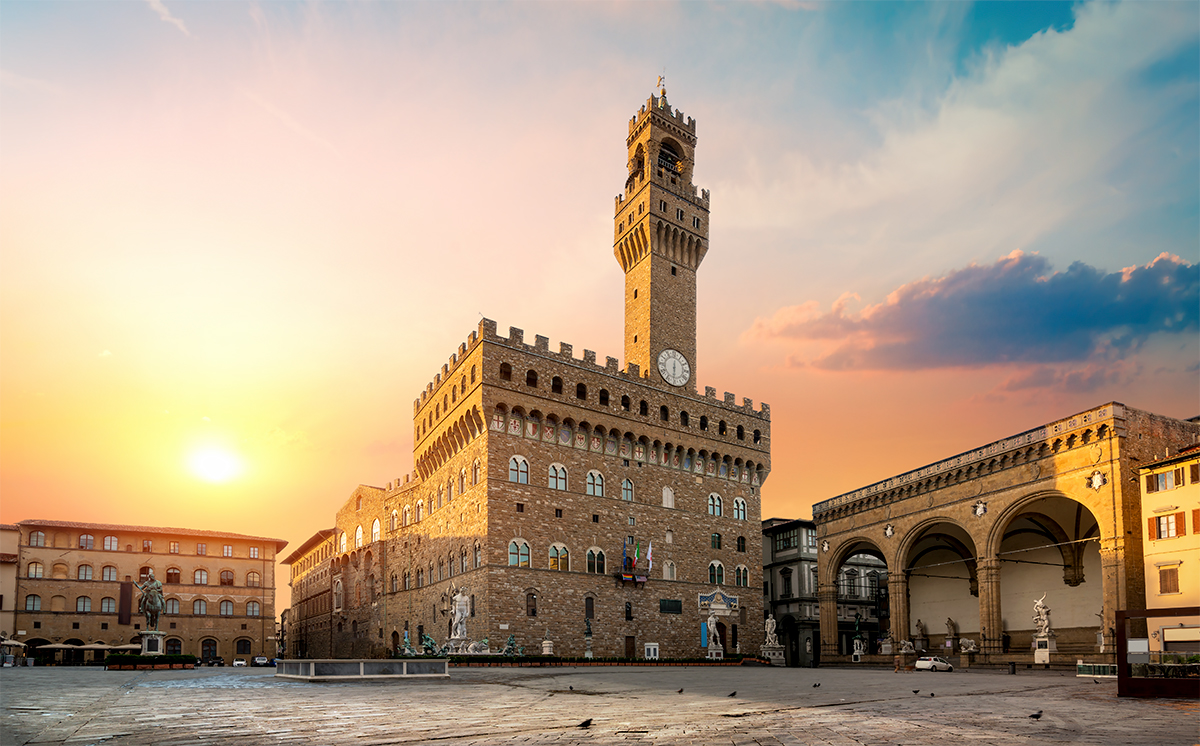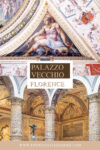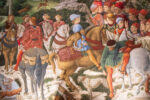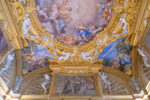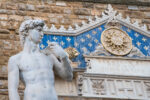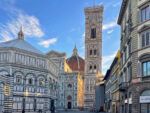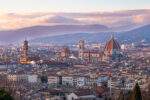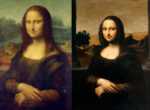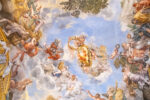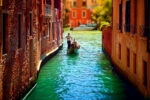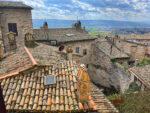Towering over the southeast corner of Piazza della Signoria, Palazzo Vecchio looks more like a fortress than a palace. And that is because when it was built in 1299, security was much more on Florentines’ minds than fine art. However, the interior of the palace is anything but rugged. It is exquisitely refined and a must-see in Florence, even if you only have 1 or 2 Days in Florence.
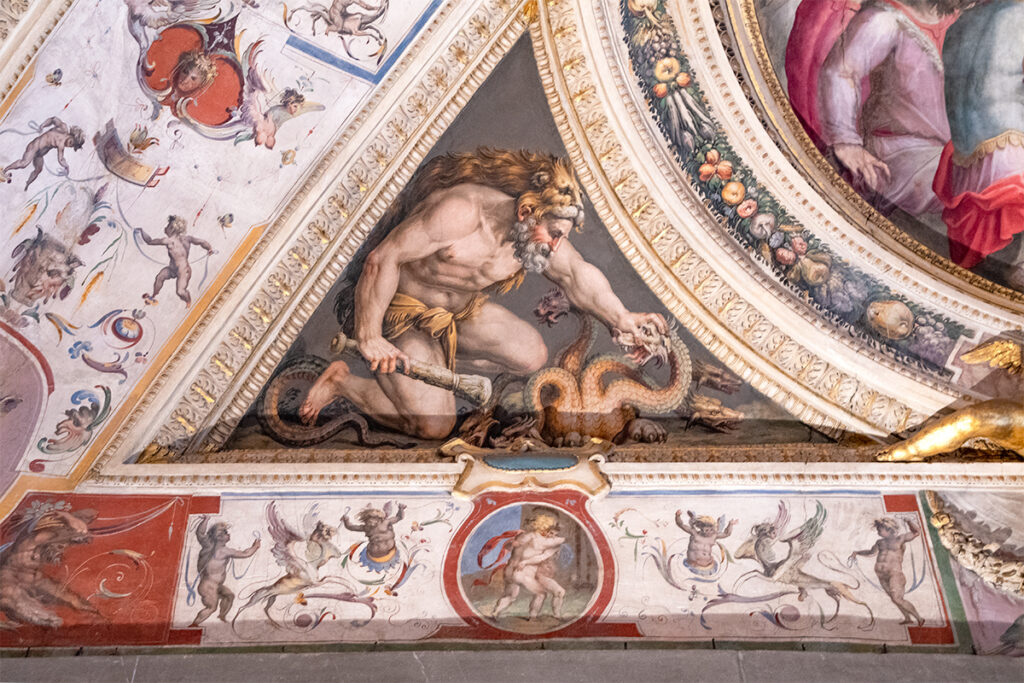
The square in front of the palace, Piazza della Signoria contains more public Renaissance art than anywhere else in Florence. Michelangelo’s David (a replica) and Bandinelli’s Hercules and Cacus guard the entrance to the palace.
Another colossal male nude – Neptune, towers over a marble fountain next to Donatello’s Judith and Holofernes. Loggia dei Lanzi next to the palace, is an open-air sculpture gallery crowned by Bellini’s magnificent Perseus with the Head of Medusa.
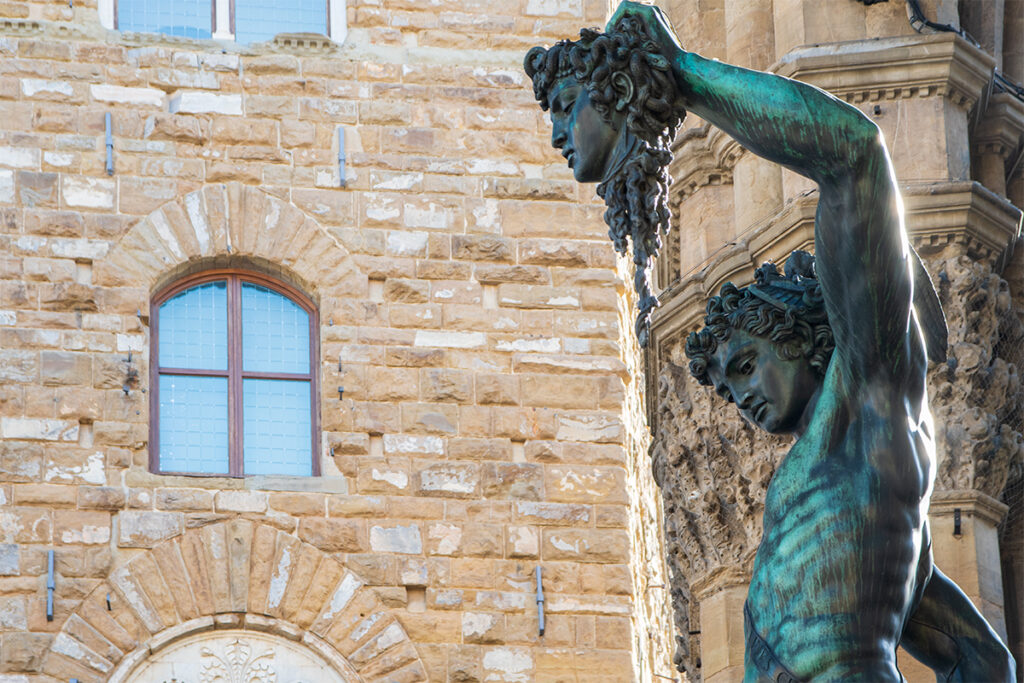
The interior of Palazzo Vecchio makes you feel like you are walking inside Renaissance paintings, some of which conceal secret passageways that run throughout the building.
Most rooms in the palace are decorated with themes of Greek and Roman mythology integrated with extravagantly bizarre shapes and creatures of the grotesque style. It’s a refreshing change from the religious themes of the Middle Ages.
Palazzo Vecchio Tickets
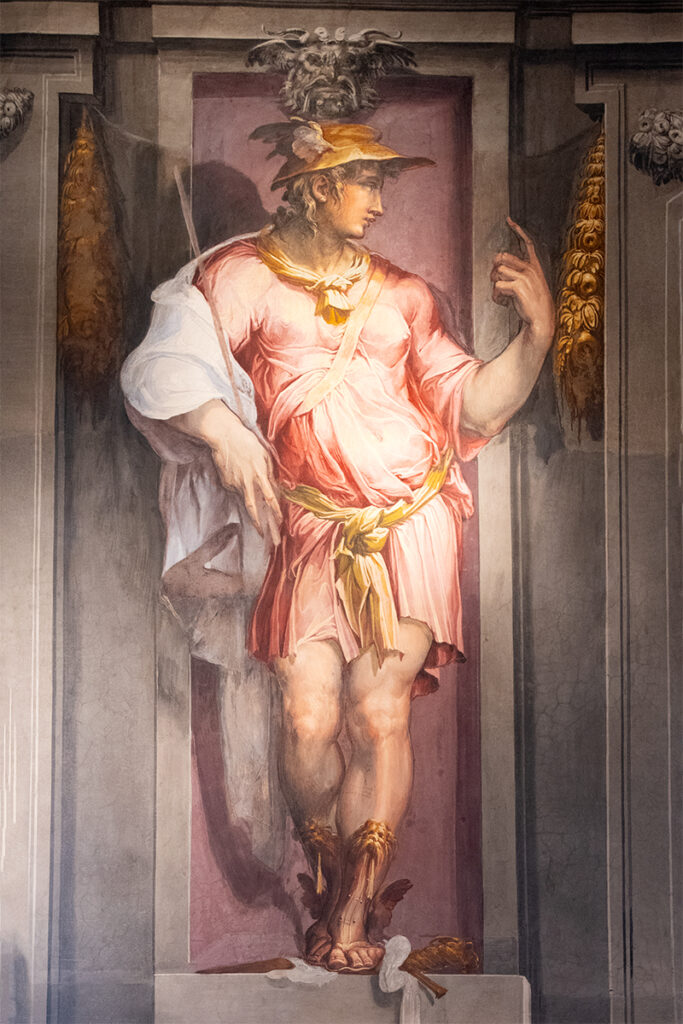
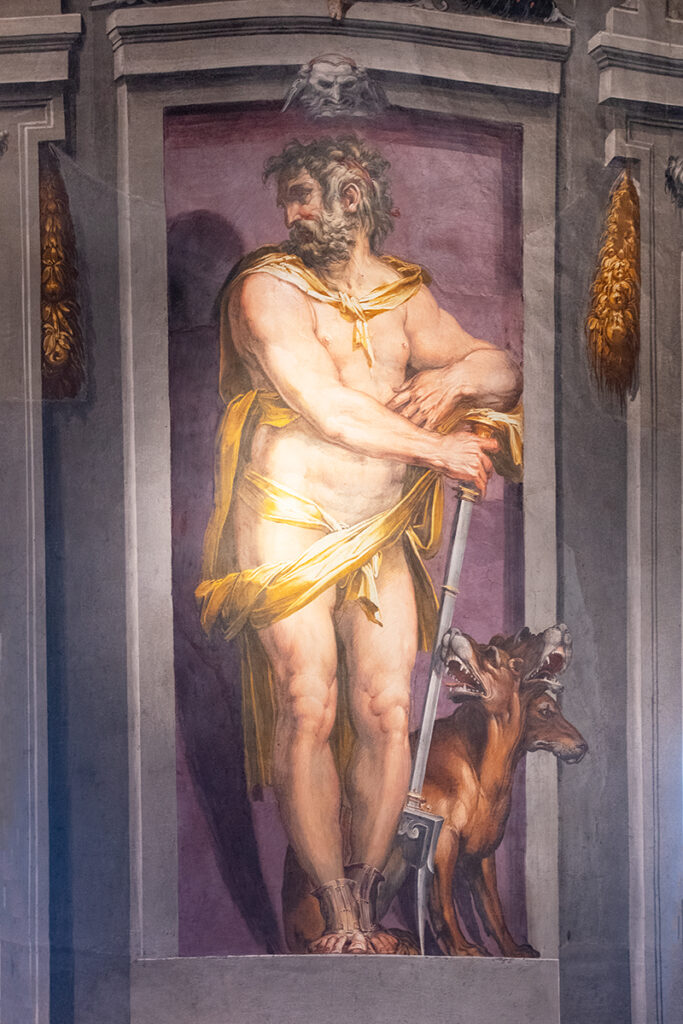
Independent Visit
There are several options for visiting Palazzo Vecchio. You can visit the palace independently. Simply buy your entry ticket and explore the palace at your own pace. The official booking site for Palazzo Vecchio tickets is the website for civic museums in Florence. Keep in mind that you’ll need to exchange your electronic ticket for a paper one at the palace’s ticket office, and it can take some time.
The palace has sufficient signage, so you’ll know what you are looking at. You can also grab a video guide with your ticket if you’d like a bit of a guiding experience. Whatever ticket you pre-book, you’ll need to exchange your digital booking for a paper ticket in the ticket office on the ground floor.
Unfortunately, you can’t buy tickets for Palazzo Vecchio’s Tower – Torre di Arnolfo on the civic museums’ site. Tiqets is the only platform that offers combined timed-entry tickets for the Palace, the Tower & a Video Guide that you can buy in advance.
Palazzo Vecchio Tours
There is a lot to see in the palace, and if you are interested in the Medici family, you’ll want to know the context and the stories behind some of the palace’s halls and famous art pieces. And, of course, the best way to learn while enjoying the beautiful art is to join a guided tour.
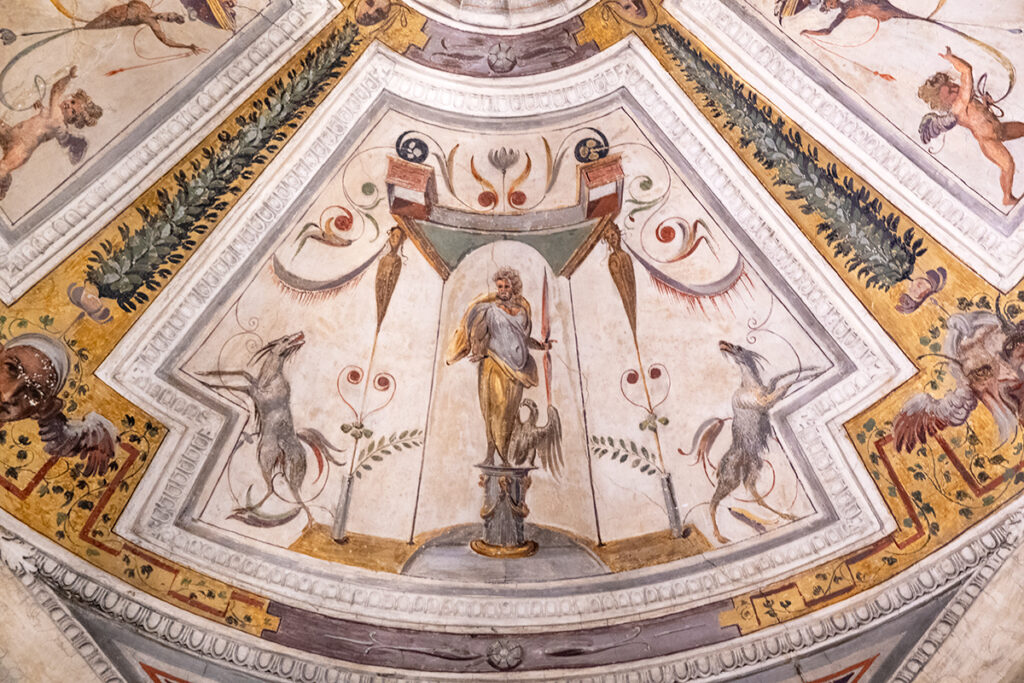
Want to know where Vasari’s secret sign “Cerca Trova” is located on his enormous fresco – the one made famous by Dan Brown’s Inferno movie? You’ll struggle to see it without a guide. Don’t want to miss Dante’s death mask? Wondering why there is a giraffe next to Lorenzo il Magnifico (the Magnificent) in a fresco? There is a lot of value in visiting such artistically and historically complex monuments with a professional guide.
If you are travelling as a group or a family, you might like to opt for a private tour of the Palace that includes the Arnolfo Tower.
Palazzo Vecchio Secret Passages Tour
This tour is a real treat. It is curated by the museum staff and offered only twice a day. From the get-go, the tour takes you into a secret passage and plunges you into medieval Florence. You move between the areas of the palace via the passages concealed within its walls, entering secret nooks and crannies built as sanctuaries by the Medici family members.
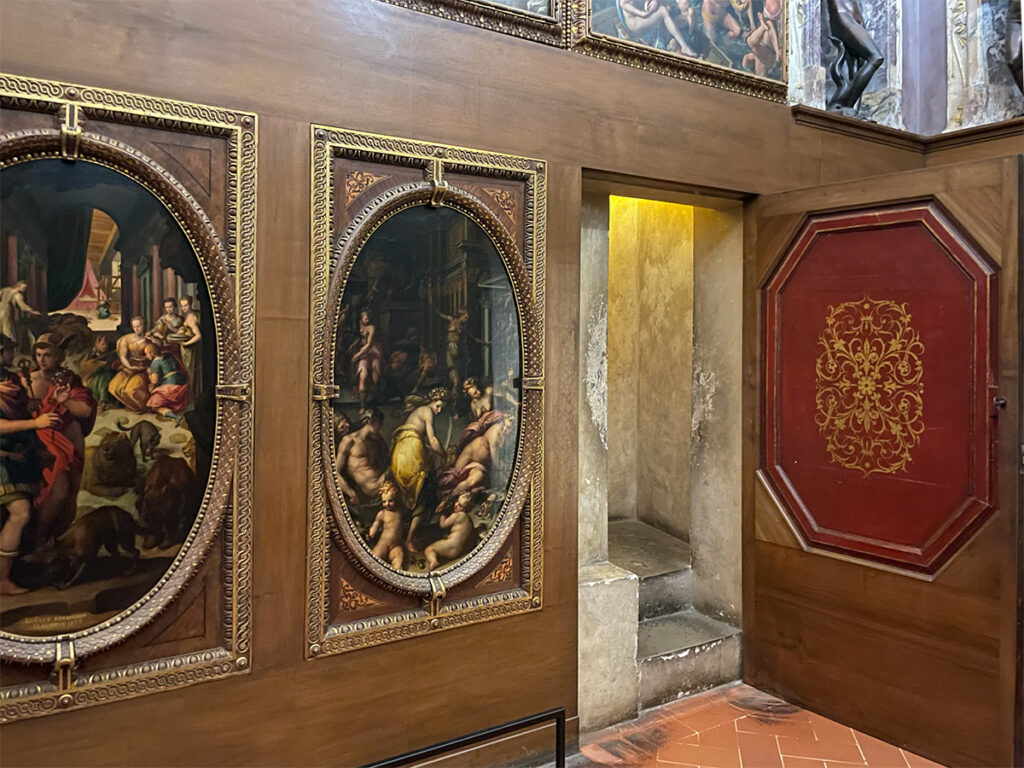
.
Along the way, you learn about symbols and hidden meanings in the art surrounding you, and by the end of the tour, you’ll be spotting a tortoise with a wind-filled sail on its back everywhere (it’s a symbol of Cosimo I). And the best part? You are welcome to stay in the palace and explore the rest of it independently after the tour.
Brief History of Palazzo Vecchio
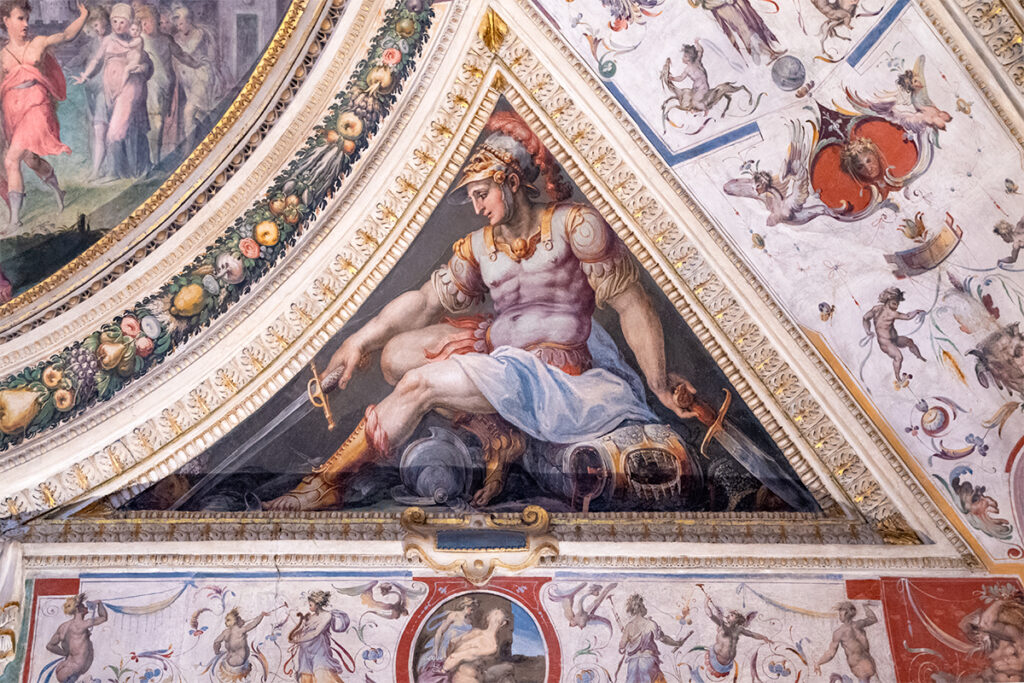
It was built in 1299 to house the government of Florence, which at the time was constituted of 8 elected Priors who represented the different trade guilds. Dante Alighieri was one of the priors and lived in this palace during his term. The name of the palace at that time was Palazzo dei Priori (Palace of the Priors).
In the following century, the structure of the government changed from the 8 priors to just one man – Seniore de Firenze. The palace was renamed accordingly – Palazzo della Signoria (Palace of the Seniore).
The first Seniore of Florence was a foreigner – the Duke of Athens, Gualtieri di Brienne and he wasn’t liked by the Florentines. Fearing for his life, he commissioned a secret escape corridor, the Duke of Athens staircase, to be built so he could leave the palace unseen. The corridor terminated at a small door that could only be opened from the inside. This is the door Robert Langdon and Siena used to escape the palace in Dan Brown’s Inferno.
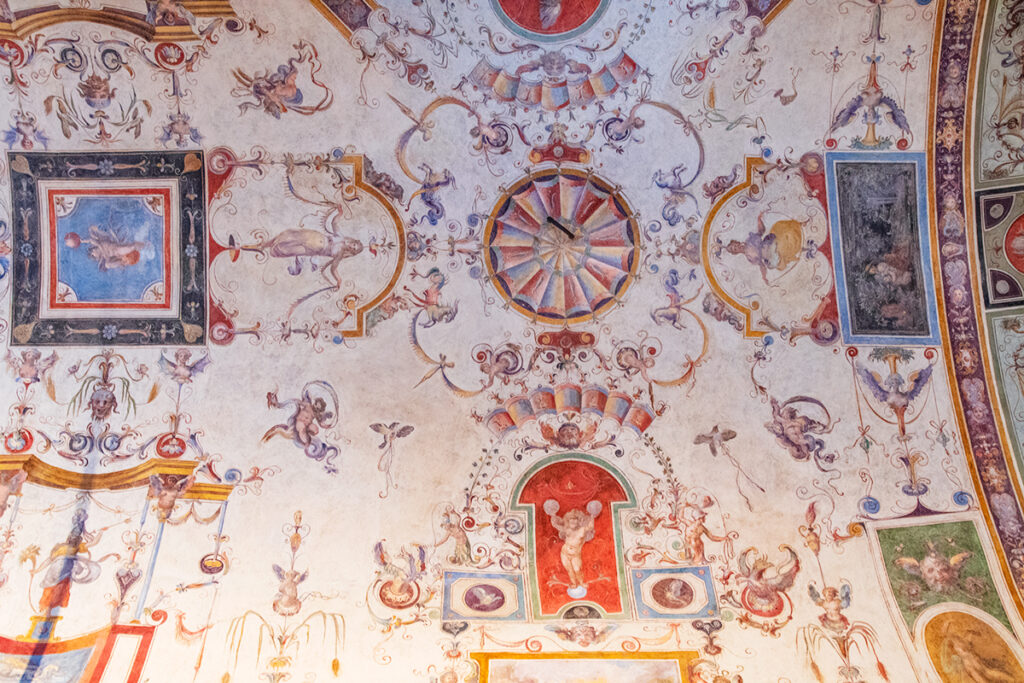
The palace came into its golden age in 1540 when Cosimo I de Medici became the Duke of Florence and moved his official seat here from the original family palace that today is called Palazzo Medici-Ricardi. While the Medici only occupied Palazzo Vecchio for nine years before moving to Palazzo Pitti across the Arno River, these nine years were the palace’s glory days.
The current interiors of the palace (the parts of it that are open to the public) are the result of a major remodelling by Giorgio Vasari – the go-to artist and architect in 16th century Florence, on commission from Cosimo I.
Vasari was not only a painter, architect, and engineer but also the world’s first art historian. The term “Renaissance” first appeared in his most famous work, “The Lives of the Most Excellent Painters, Sculptors and Architects”. “Renaissance” means rebirth and refers to a return to the classical art of Ancient Greece and Rome
When the Medici moved their residence to the Pitti Palace, this palace became ‘the Old Palace’ or Palazzo Vecchio.
The First Courtyard
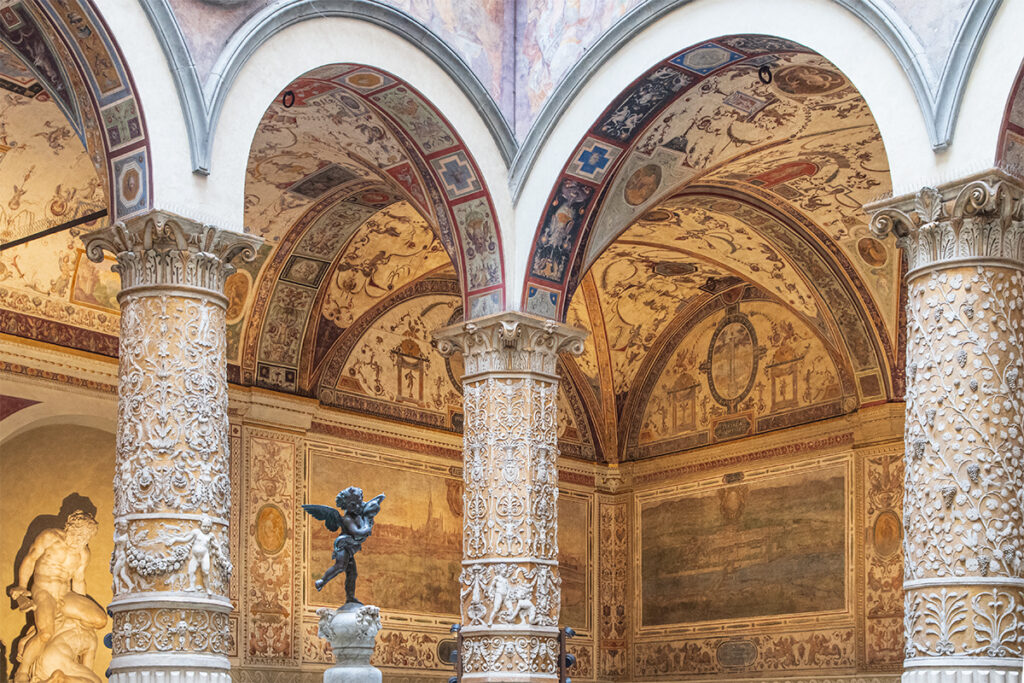
Just inside the main entrance is the first courtyard of Palazzo Vecchio, designed by Michelozzo in 1453. The courtyard’s centrepiece is a small statue of Pluto with a dolphin by Verrocchio, a famous Florentine artist who took the young Leonardo da Vinci as an apprentice in his workshop. The sculpture in the courtyard is a replica of the original that now stands inside the palace in the Apartments of the Elements.
The courtyard was given an uplift by Vasari in 1565 for the wedding of Francesco I and Joan of Austria. To welcome Francesco’s wife, the courtyard was painted with scenes of Austrian cities, while the ceiling was decorated in the fanciful grotesque style.
The Second Courtyard
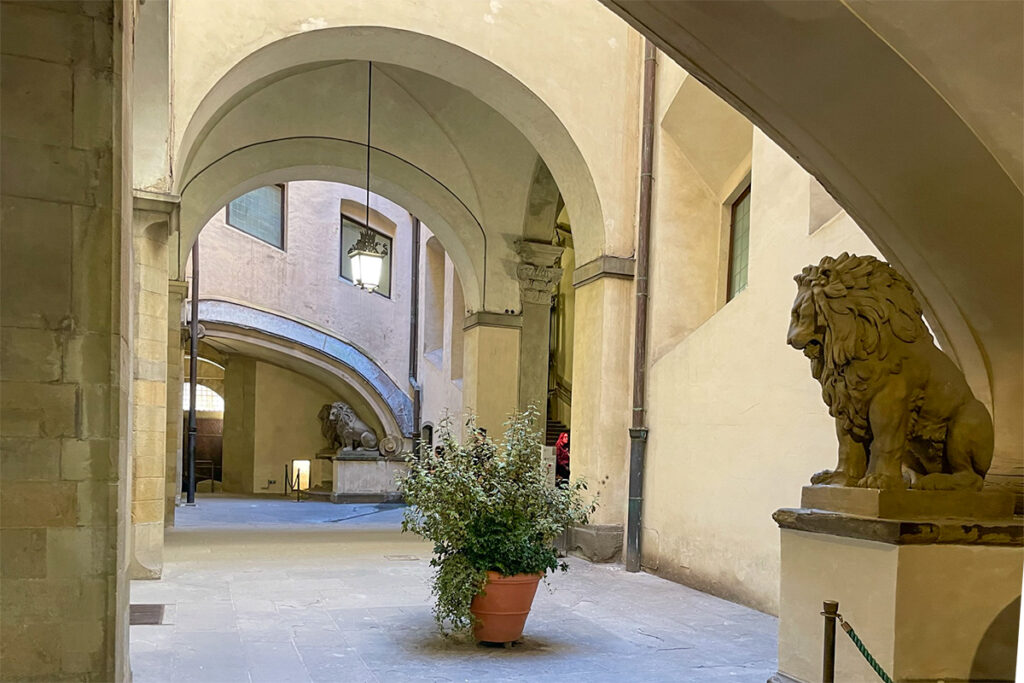
The second courtyard is rather plain and sparsely decorated. On the side where Palazzo Vecchio faces via della Ninna, next to a large wooded door, there is a small door with no handle on the outside. This is the door at the end of the Duke of Athens staircase, the one that Robert Langdon and Siena Brooks used to escape the palace in Dan Brown’s novel.
In the time of the Duke of Athens, there was no street next to the palace. Instead, a church stood right next to it, so the Duke could leave the palace unseen by entering the church through his secret door. You can still see the church columns that have been incorporated into the building on the other side of via della Ninna.
There is a hidden gem lying beneath Palazzo Vecchio – the ancient ruins of the Roman theatre of Florentia, completed in the 1st century AD. In the past, you could access the archaeological site via a staircase next to the ticket office in the second courtyard. Unfortunately, the site is now deemed unsafe for tourists and can’t be visited.
The First Floor
The first floor of Palazzo Vecchio was intended for public meetings and celebrations. Its dominated by the monumental Hall of the Five Hundred, or Salone dei Cinquecento, named for its proportions that could fit five hundred people.
The Hall of the Five Hundred
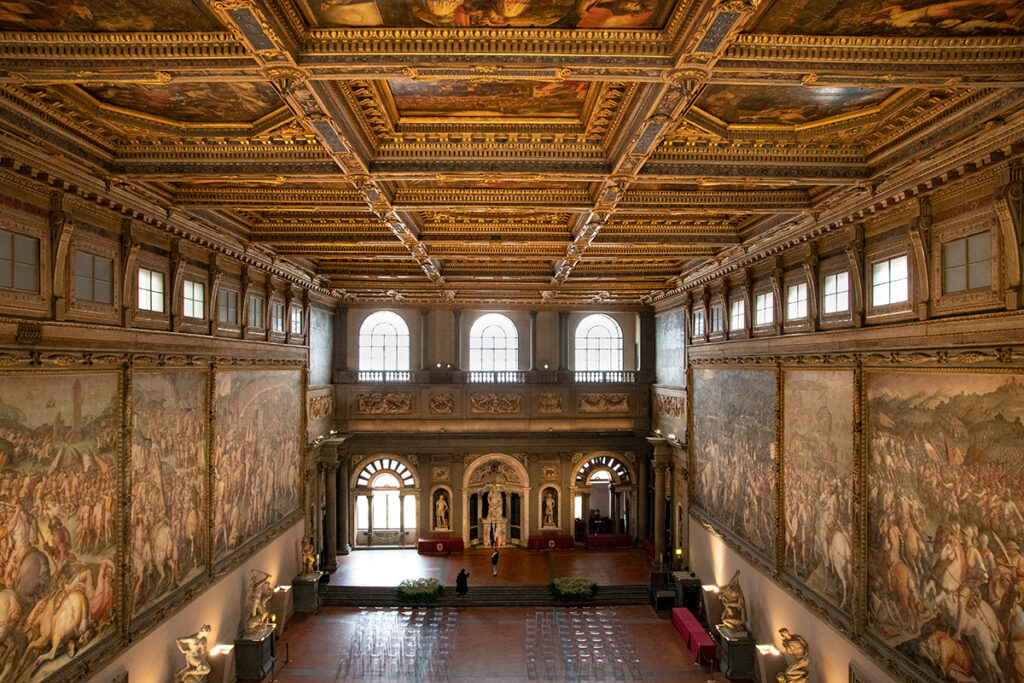
The hall was initially built as the Hall of the Grand Council – the seat of the Signoria during the Florentine Republic. When Vasari was commissioned to remodel the palace for Cosimo I, he raised the ceiling of the Hall of the Five Hundred by a whopping seven meters, bringing it to a total height of 18 meters.
The extraordinary ceiling is an artistic map of Tuscany. The centre panels represent the history of Florence; the ones on the right are scenes from the war with Siena, and on the left, the war with Pisa.
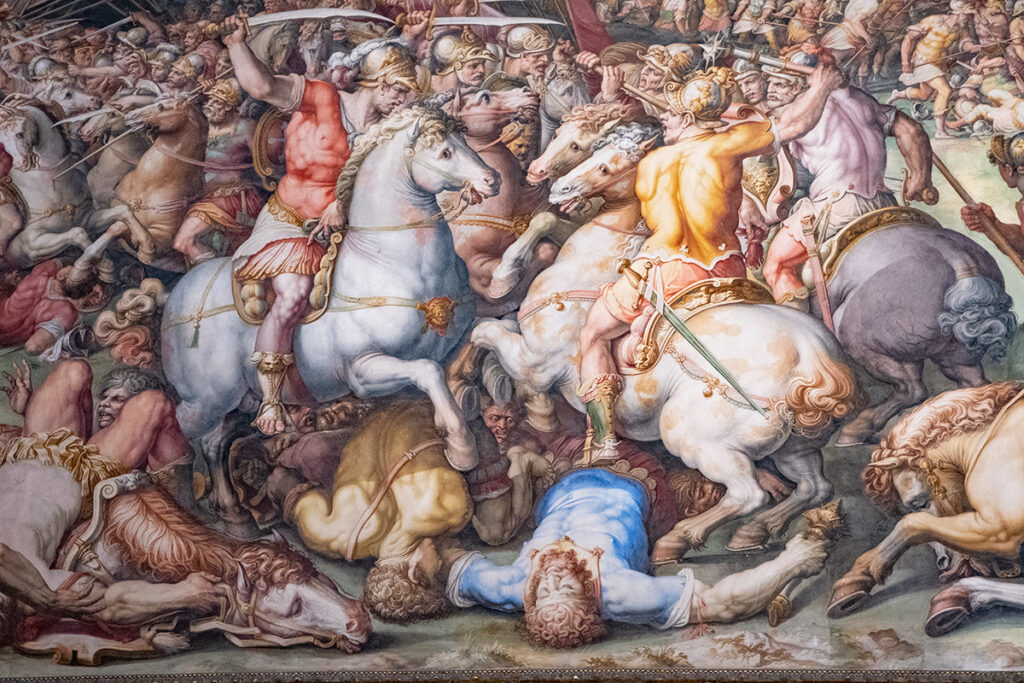
The walls are covered with 3-story-high frescoes depicting scenes from Florentine history. The last fresco on the right (war with Siena side), is Vasari’s Battle of Marciano. Beyond being visually striking, this fresco holds an exciting secret.
Lost Leonardo da Vinci Fresco
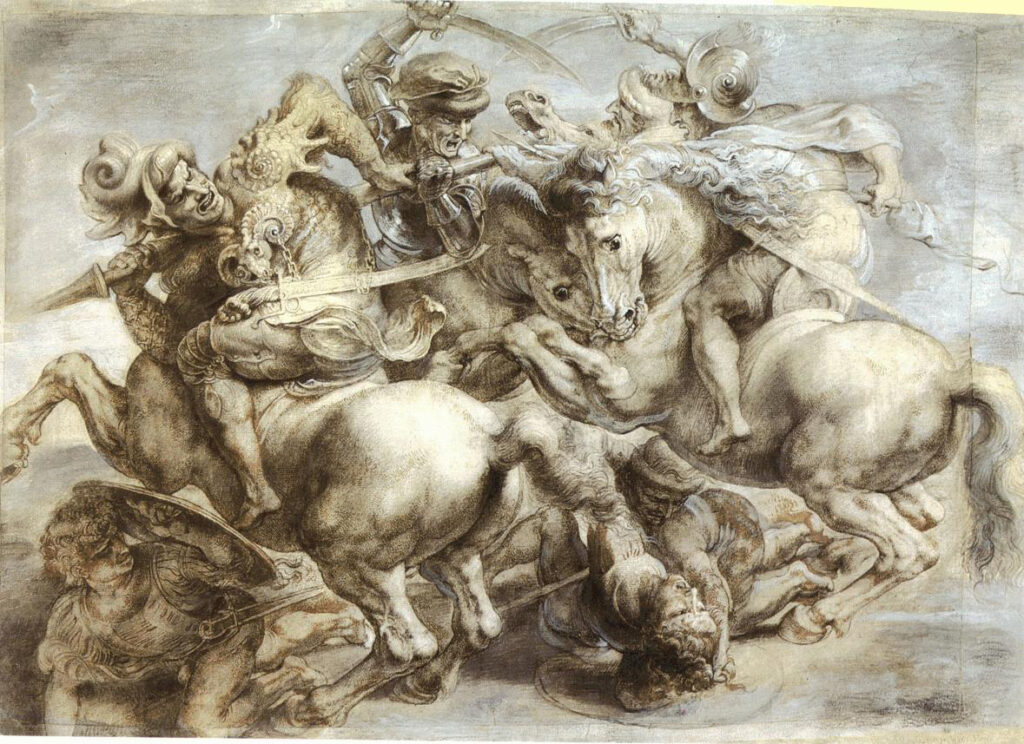
Sixty years before Vasari’s renovations, Leonardo da Vinci was commissioned to paint a large fresco of the Battle of Anghiari on this wall. Ever the experimenter, and being pitted against Michelangelo, who was given the opposite wall to paint another battle (Nicolo Machiavelli’s idea), Leonardo added oil and possibly wax to his paints to make them richer. Unfortunately, the paint was too slow to dry and began to run. Frustrated, Leonardo abandoned the fresco and soon left Florence for Milan.
The unfinished fresco remained on the wall of Palazzo Vecchio, and in the intervening centuries, several artists made copies of it (one of them is displayed in the Apartments of the Elements upstairs).
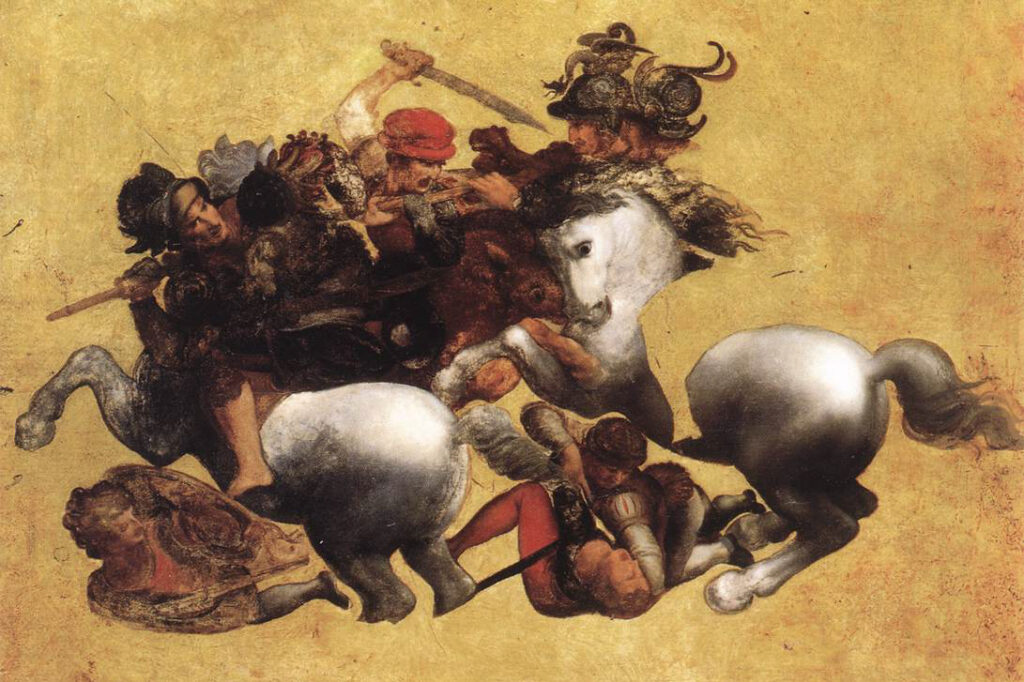
Legend has it that when Vasari was commissioned to remodel the hall, he built a false wall over Leonardo’s fresco to preserve it instead of painting over his work. Vasari left a cryptic clue on one of the battle flags on his fresco, a barely noticeable inscription 12 meters above ground that reads “Cerca Trova” or Seek and ye Shall Find. Considering that only 15, possibly 16 paintings by Leonardo da Vinci are believed to exist, the possibility of discovering the Battle of Anghiari is fascinating.
There have been several attempts to examine the wall beyond Vasari’s fresco, which provided promising but inconclusive results and in 2012, efforts to investigate further were discontinued.
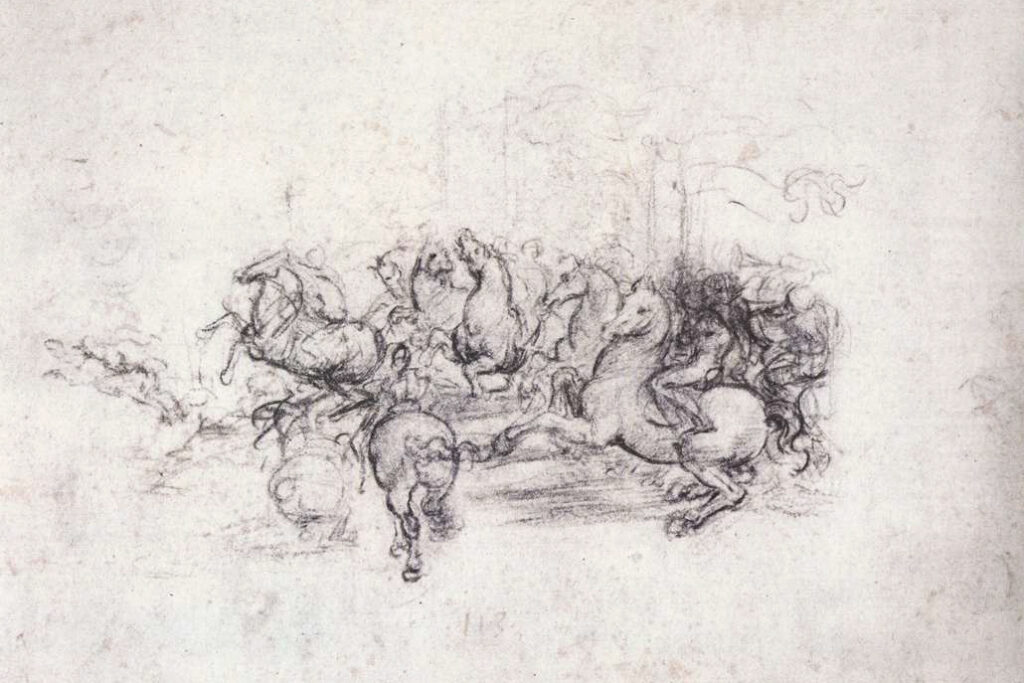
While you are gazing at the epic frescos and the ceiling, don’t miss the statues lining the perimeter of the Hall of the Five Hundred. There is Michelangelo’s unfinished Genio della Vittoria, or Genius of Victory, said to be modelled on Tomasso dei Cavalieri, a young Roman nobleman who Michelangelo was infatuated with.
Studio of Francesco I
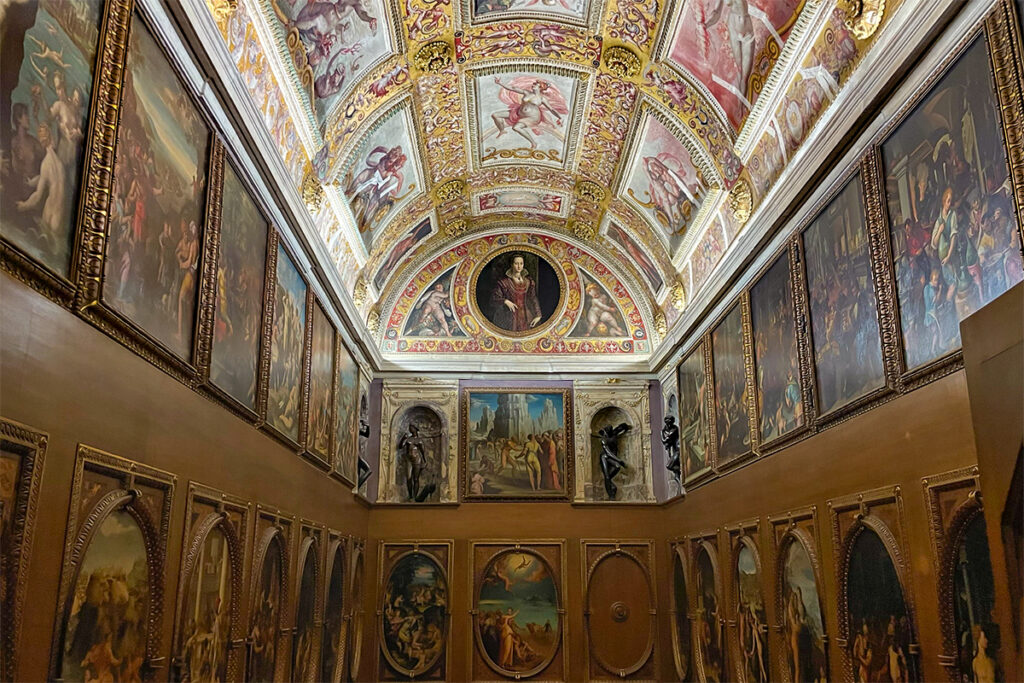
At the back of the Hall of the Five Hundred, two doors lead to some of the most beautiful and elegant rooms in all of Florence. On the right is the Studio of Francesco I, Cosimo’s son, who became the second Duke of Florence after his father’s death.
The Studio was Francesco’s study room. In 16th-century Italy, a study room was more like a cabinet of curiosities than a room for working or studying. They served as safe hiding places for items that needed to be kept away from prying eyes.
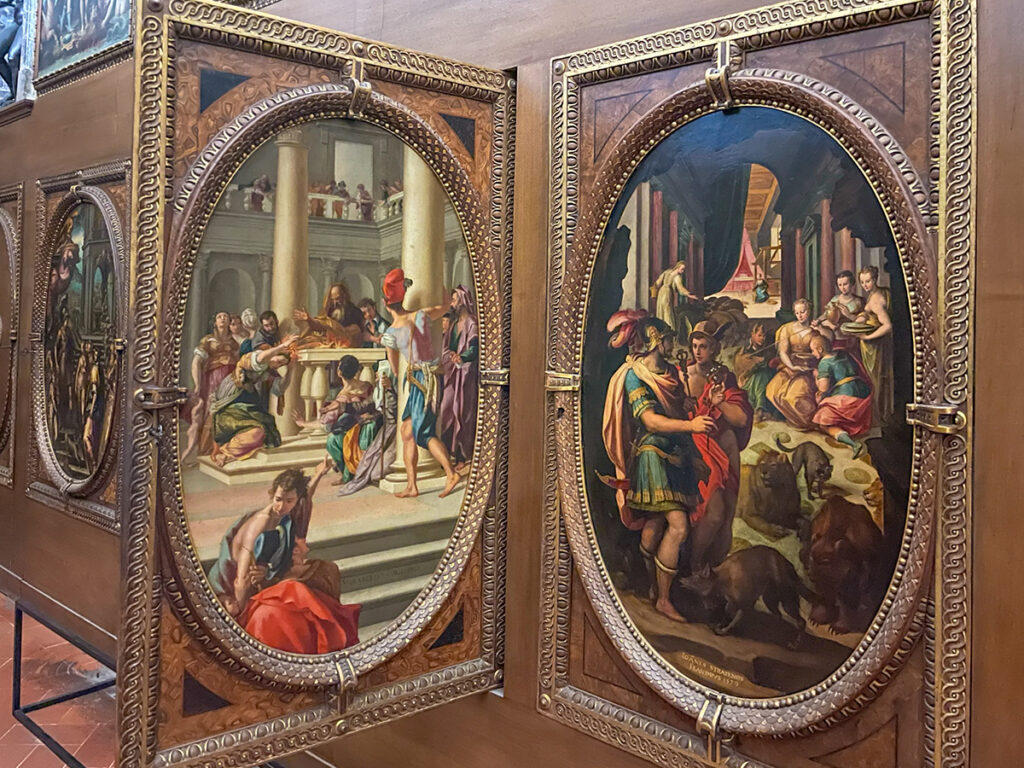
Each painting panel in Francesco’s study room conceals a cabinet. You can see keyholes in the panels if you look closely. Francesco was more interested in alchemy than in politics, and this room represents his passion for ancient knowledge and beliefs.
And there are more secrets in this room than hidden cabinets and symbolic paintings. One of the panels opens up to a concealed narrow staircase that leads upstairs to Cosimo’s study room.
You can see all these hidden treasures for yourself by joining the Secret Passages Tour. If you are a fan of Dan Brown’s Inferno, this tour is a must.
Leo X Apartments
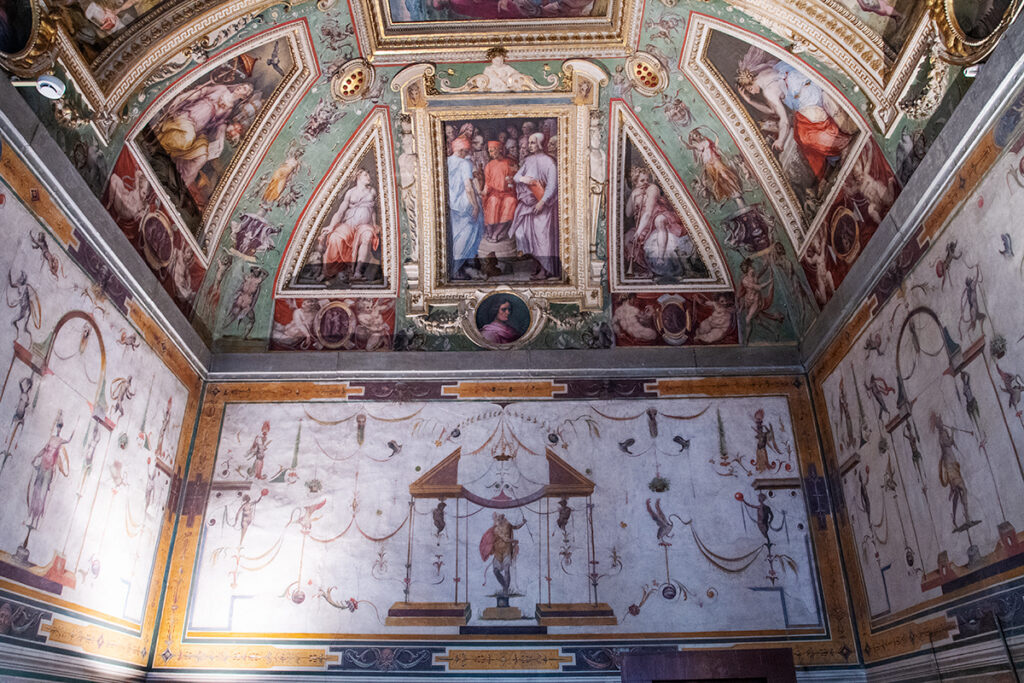
The door on the left leads to the guest apartments, called Leo X Apartments. These are my favourite rooms in the palace.
First up is the room of Cosimo il Vecchio – the first Medici to establish the family, effectively, as the rulers of Florence. This room is decorated in a distinct style, unlike the early Renaissance of da Vinci and Botticelli. It is called the grotesque style, and the story of its discovery is fascinating.
Artists of the Renaissance drew their inspiration from classical Greek and Roman art. But at the time, surprisingly few traces of Roman art and culture existed. Most of the ancient ruins in Rome were buried several meters under the street level (including most of the Roman Forum!).
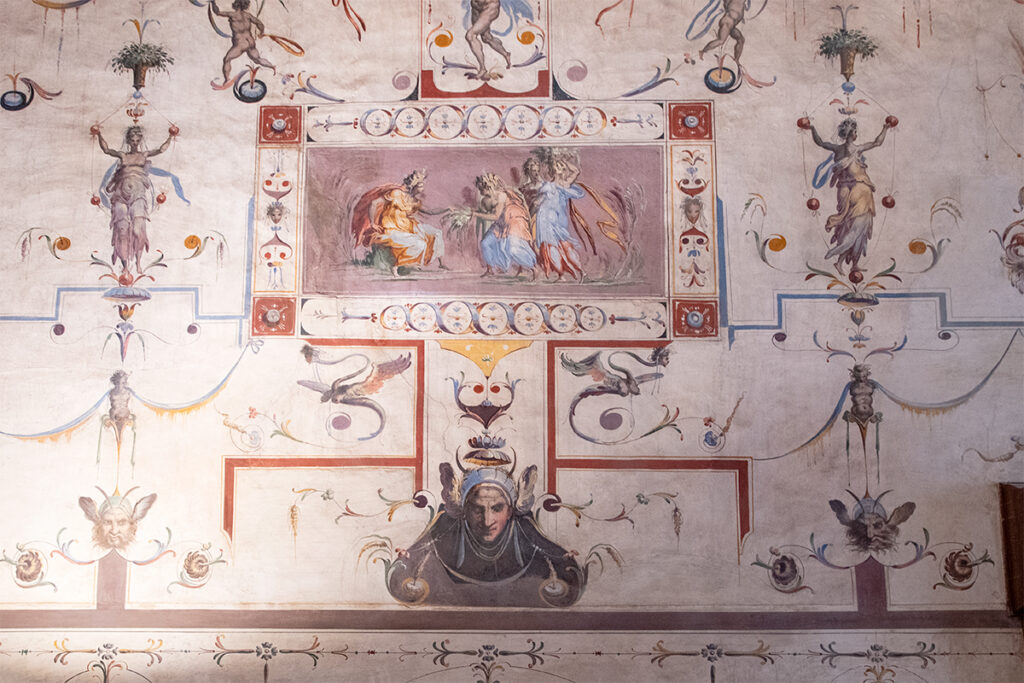
Thankfully, sometime in the early 15th century, a Roman pedestrian fell into a hole in the ground and found himself in a grotto decorated with beautiful frescoes painted in an unusual style that combined real elements of nature with fantastical ones in an extravagant and dream-like fashion.
Soon the grotto became a site of pilgrimage for Renaissance artists. Rafael, Michelangelo, Ghirlandaio, and Filippino Lippi, all climbed down the ropes into that grotto and were greatly inspired by the frescos. The style became known as “grotto-esque” or grotesque.
Only recently, archeologists discovered that what the Renaissance artists thought to be a grotto was the roof of the famed Nero’s Golden Palace, built in the first century AD. After Nero’s death, the next emperor, Trajan, had the palace filled with rubble and built public baths on top of them. And for 2,000 years, the palace was considered to be lost.
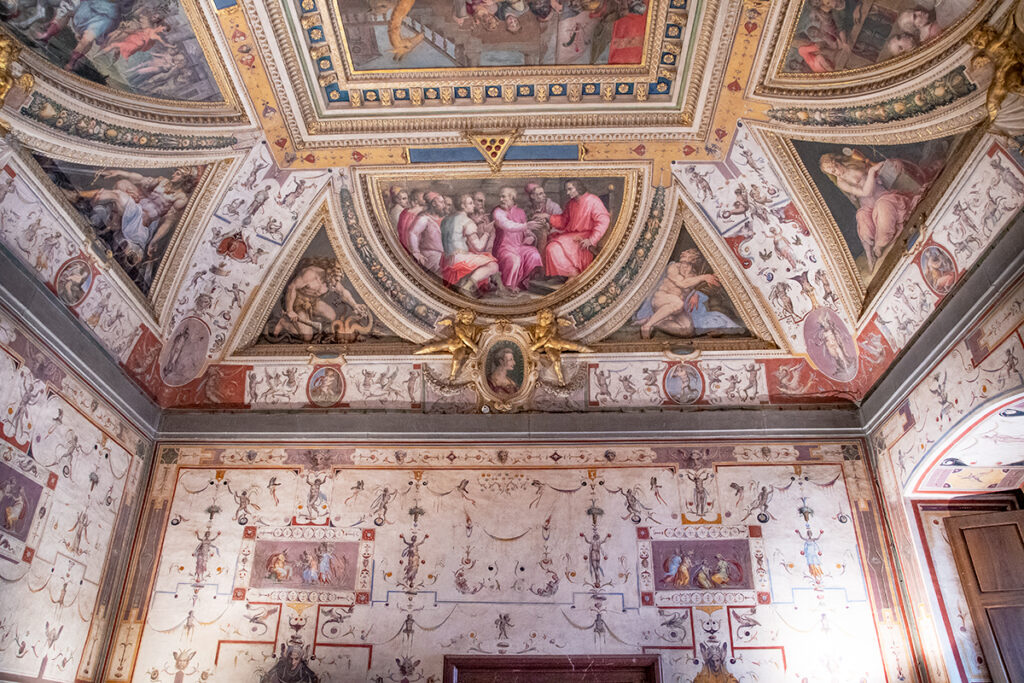
The adjoining room of Lorenzo if Magnifico is as beautiful as Cosimo’s, and its most interesting piece is the fresco on the ceiling. In this fresco, Lorenzo is depicted surrounded by foreign ambassadors accompanied by exotic people and animals, including lions, camels and a giraffe.
The final room in these apartments is the Room of Leo X, Lorenzo’s son Giovani de Medici, the first Medici pope.
These rooms in Leo X apartments are aligned with the rooms upstairs that celebrate mythological gods and beings. This pattern reinforces the connection between the gods above and the gods on earth – the Medici.
The Monumental Staircase
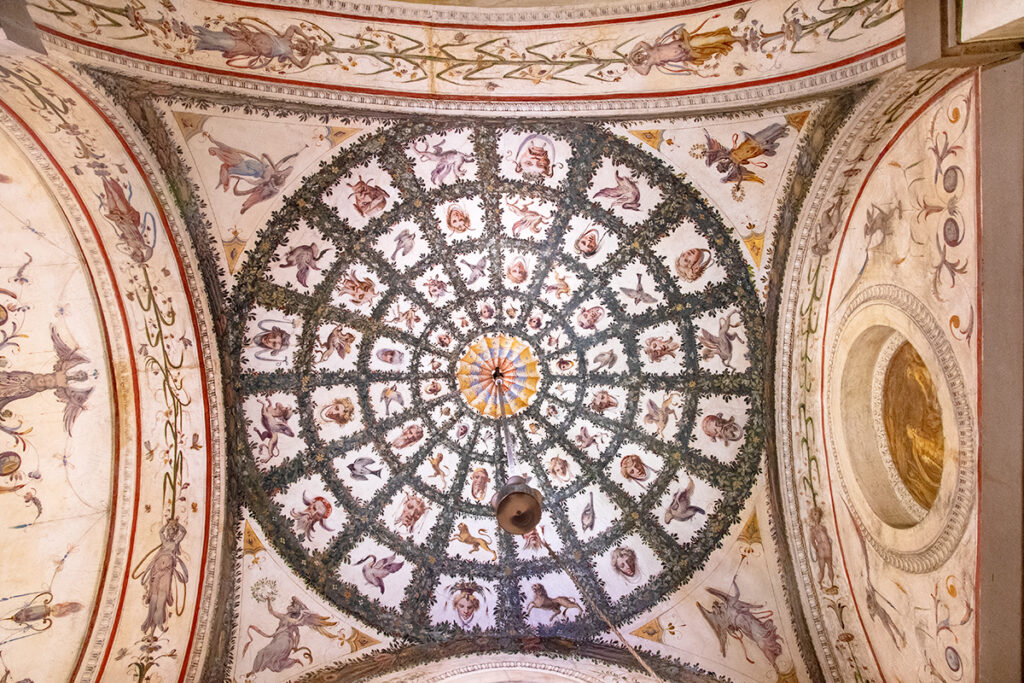
The Monumental Staircase connects the Apartments of Leo X on the first floor with the Apartments of the Elements on the second floor. It is decorated with surrealistic patterns of grotesques and ghiribizzi (whims).
The ceiling of the first landing is painted to create the illusion of a bright sky peeking through the wooden trellis covered in vines. The ceiling above the second landing keeps to the same theme but has a more geometric appearance and features all sorts of fantastical beings.
The Second Floor
The second floor of Palazzo Vecchio is taken up by the royal apartments. Left of the staircase are the apartments of Cosimo I, known as the Apartments of the Elements, for their artistic theme. To the right of the staircase are the Apartments of Eleanora de Toledo, Cosimo’s wife and the Dutchess of Tuscany.
Apartments of the Elements
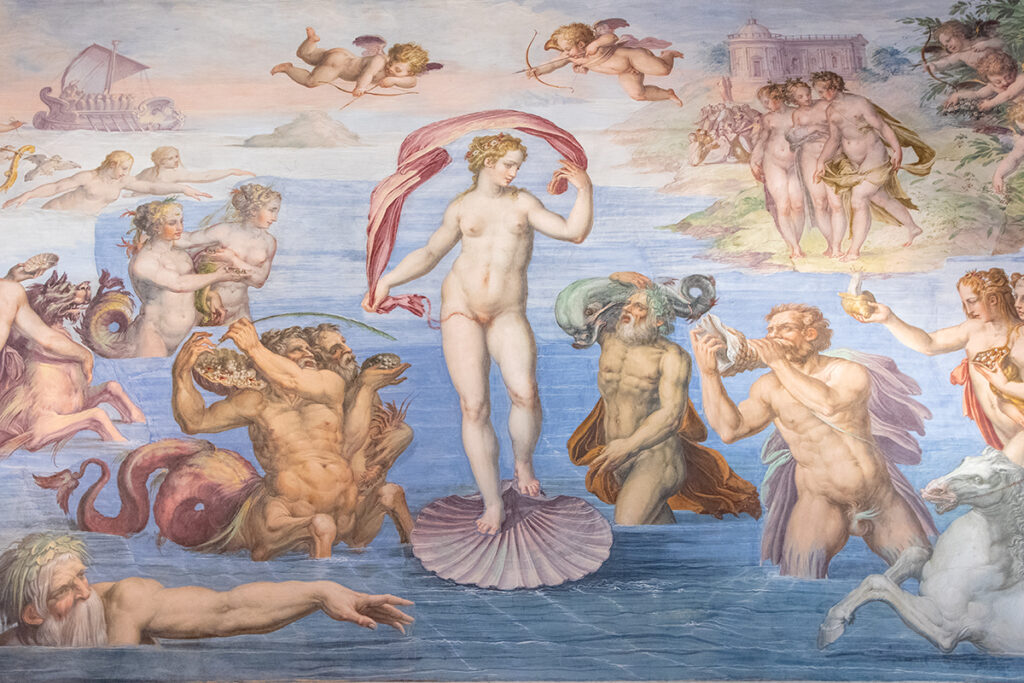
In the Apartments of the Elements, each room is dedicated to a mythological deity and matches a room on the floor below devoted to a member of the Medici family.
The most striking room in the apartment is the Hall of the Elements. In fact, it is one of the most artistically beautiful rooms in Palazzo Vecchio.
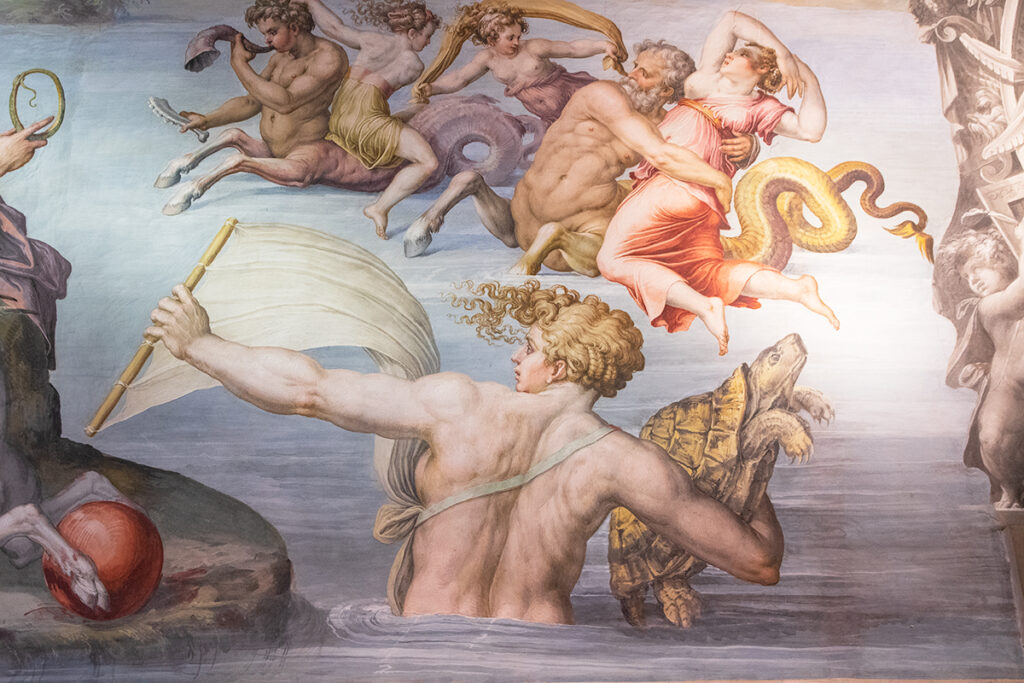
The monumental frescoes in this room represent the birth of the cosmos composed of four elements. The ceiling is Air with the Sky and all its creatures. One of the walls is Water, with the Birth of Venus celebrated by sea deities and creatures; the opposite wall is Earth, with the goddess of Earth, Ceres, giving her fruits to Saturn. And on the wall of the fireplace is Fire with Vulcan, the god of Fire, forging Cupid’s arrows, aided by his wife Venus and the cherubs.
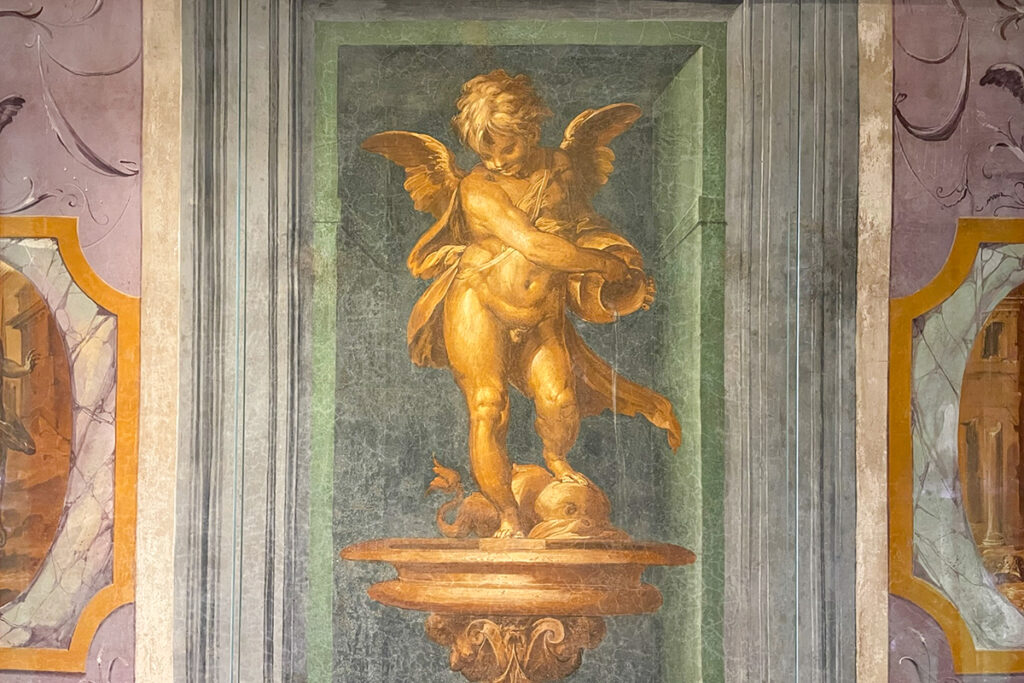
From the Room of the Elements, you make your way through the Room of Ceres, the small Study of Calliope (Cosimo I’s ‘cabinet of curiosities’), the opulent Room of Opis, Room of Jupiter, Terrace of Juno with Verrochio’s Juno with a Dolphin, and the Room of Hercules – all decorated with themes from ancient mythology.
Once you are back on the Grand Staircase, head to the right to the Apartments of Eleonora. First, you’ll find yourself on a terrace overlooking the Hall of the Five Hundred. From this fabulous vantage point, you can have a closer look at the hall’s phenomenal ceiling.
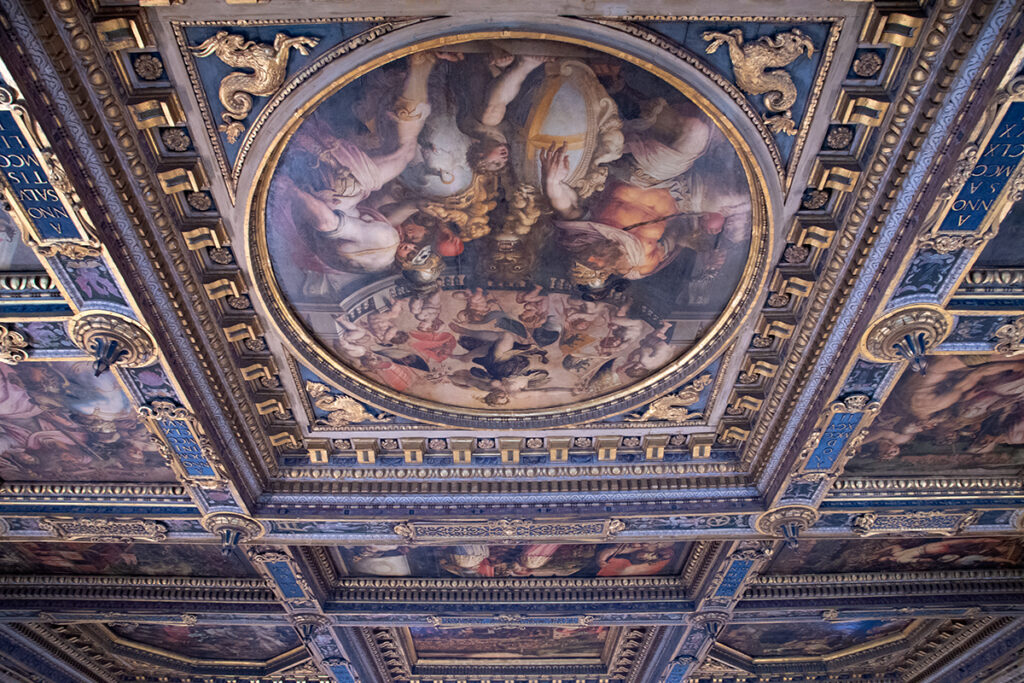
The ceiling comprises 39 enormous panels with paintings by Vasari and his workshop. To support the weight of the panels, Vasari had to create a complex system of wooden beams and supports to prevent the paintings from crashing down on the distinguished crowds below.
From the terrace, you enter the Green Room – the first room of the Apartments of Eleonora.
Apartments of Eleonora
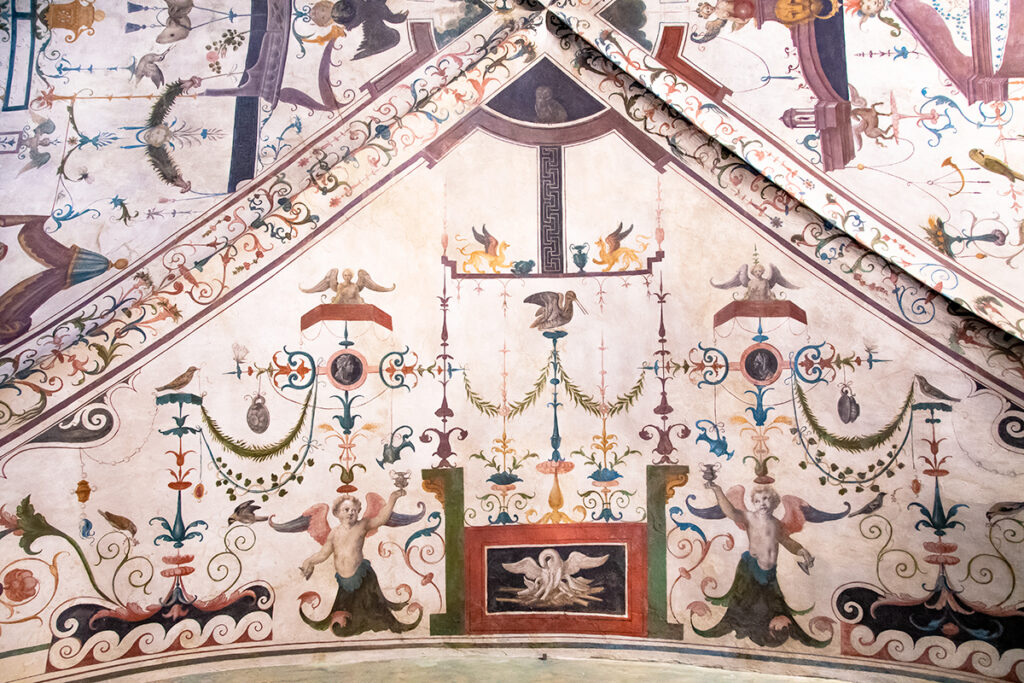
The splendid Green Room reflects Medici’s love of nature. The room is called green not so much for the colour of its wall but more for the many landscapes and creatures depicted here, which in the 16th century created the illusion of a loggia overlooking the countryside.
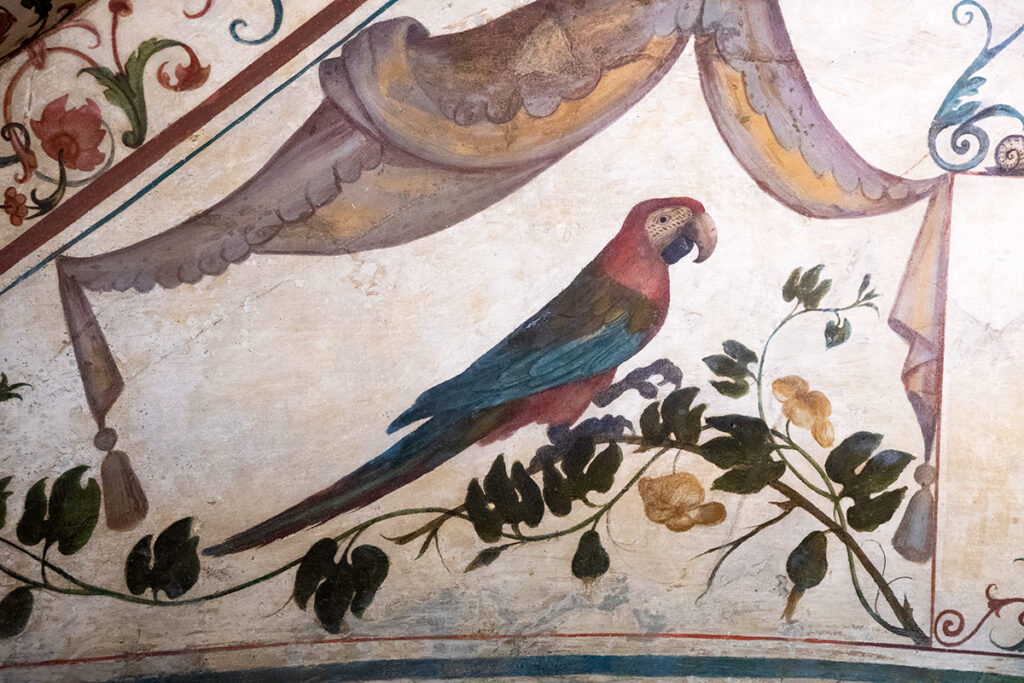
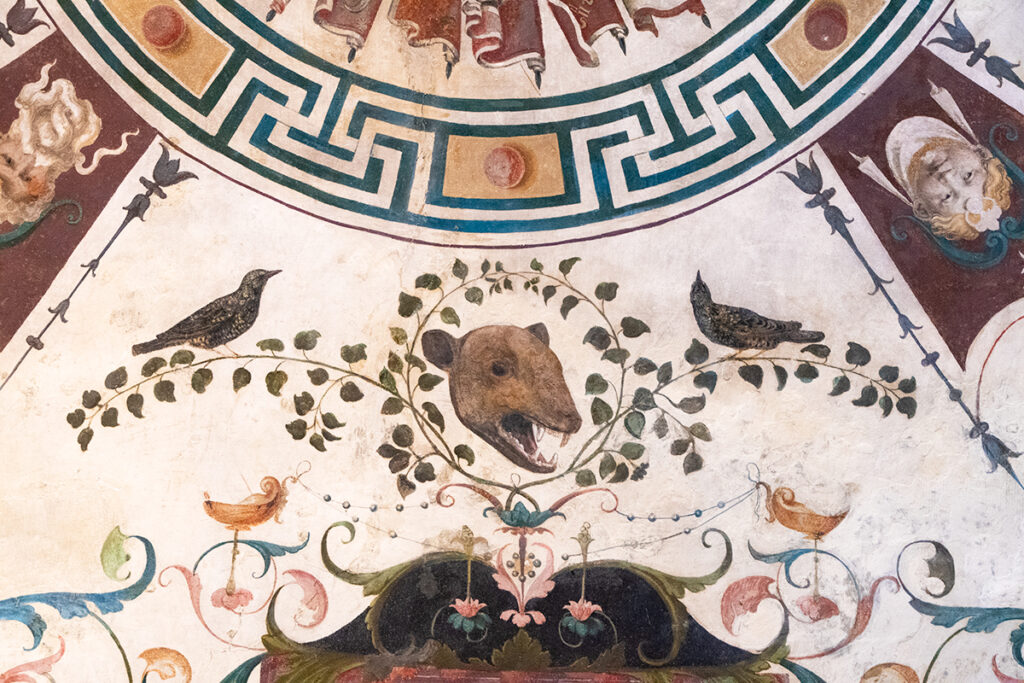
Painted by Ridolfo Ghirlandaio, son of the famous Dominico Ghirlandaio, the ceiling of the Green Room is a mystical menagerie of local and exotic animals, from African antelopes to South American macaws, to downright fantastical creatures.
There is a small door in the room, usually closed, that leads to the famous Vasari Corridor that connects Palazzo Vecchio with the Uffizi Gallery and with Palazzo Pitti on the other side of the Arno River. The corridor has been under restoration since 2006.
A local resident told me that the problem with Vasari Corridor was that there were no emergency exits, making it unsafe for modern-day tourists. The Medici obviously didn’t need emergency exits.
Adjacent to the Green Room is Eleonora’s private chapel decorated by her favourite artist Agnolo Bronzino. This stunning room is considered a masterpiece of Renaissance Mannerism.
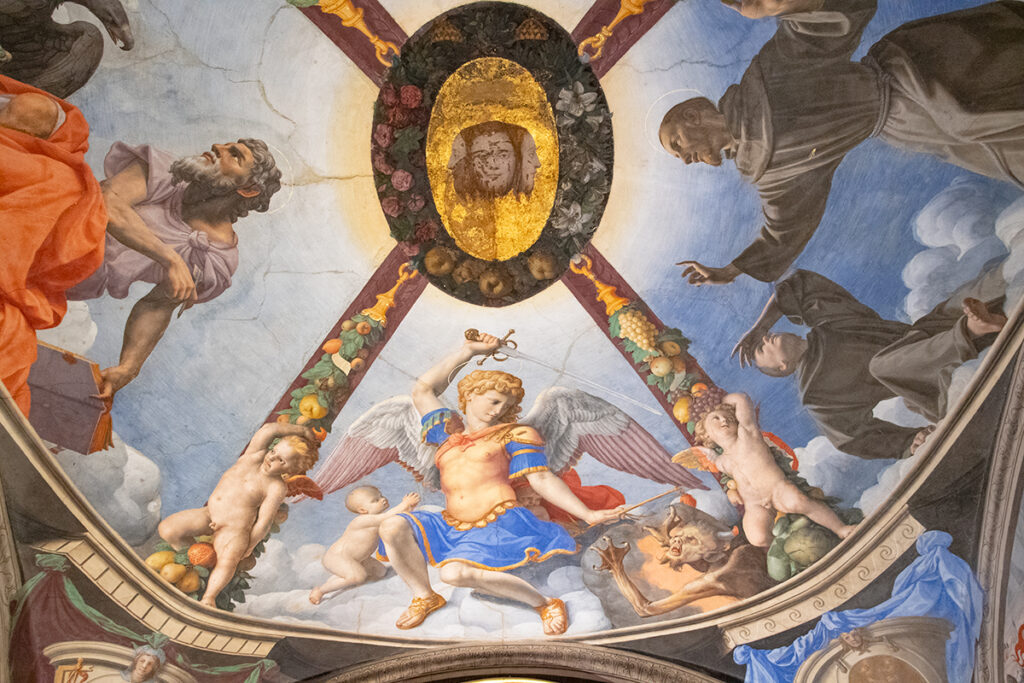
As you make your way through the next rooms: Room of the Sabines, Room of Esther, Room of Penelope and Room of Gualdra, don’t miss a copy of Leonardo da Vinci’s Battle of Anghiari – the famous lost fresco from the Hall of the Five Hundred. It is displayed in the Room of Esther.
Apartment of the Priori
From the Apartments of the Eleonore, you enter the oldest part of the palace. These rooms were used by the priori (priors) representing the guilds of Florence.
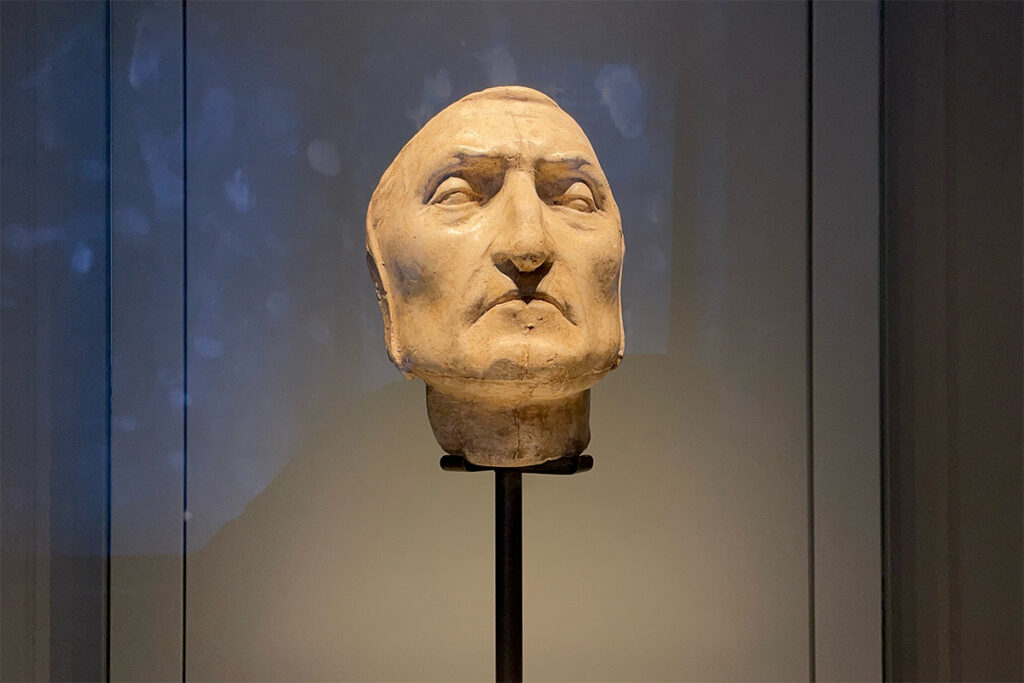
Dante’s Mask at Palazzo Vecchio
As you walk towards the Audience Chamber, don’t miss Dante’s death mask displayed in a glass case. Most people would find the sight of the mask rather morbid, but if you are a fan of Dan Brown, you’ll want to see it. The mask at Palazzo Vecchio is a plaster copy of the original Dante’s funeral mask that was moulded from his face after his death in 1321.
Before his exile, Dante served as a prior of Florence. This might be the reason why he is always depicted wearing a red cloak and a red hat. The priors’ robes were bright red.
Audience Chamber
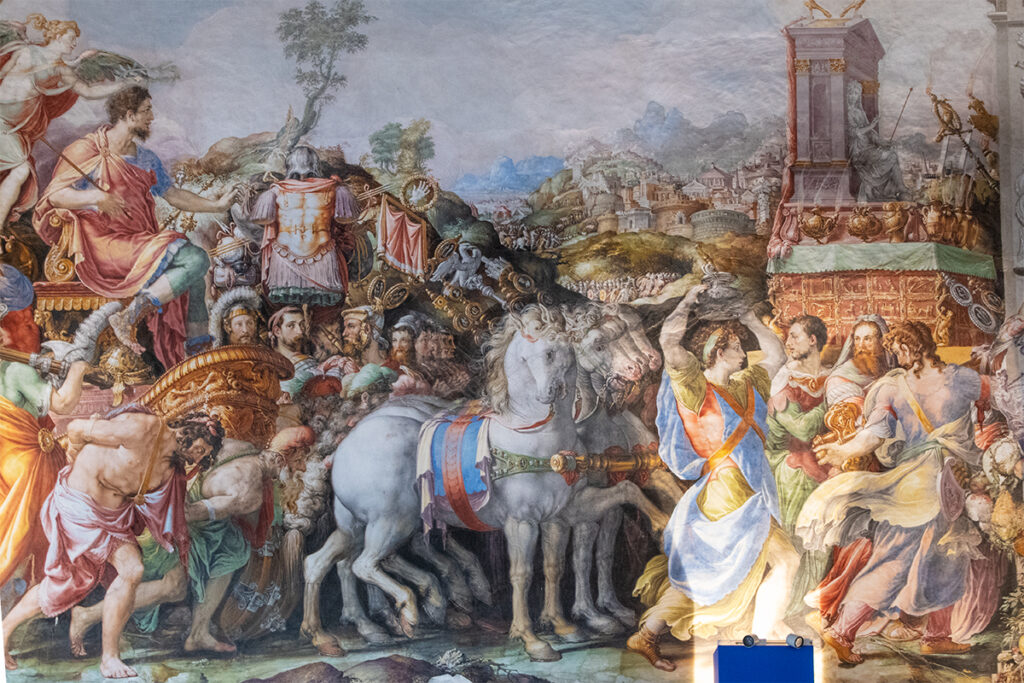
The Audience Chamber or Hall of Justice is one of the most sumptuous halls in the palace. It used to host the meetings of the priors – the Florentine government. It contains some of the oldest decorations in the palace.
The walls are covered with magnificent frescoes by Francesco Salviati, who spent much of his time working in Rome, and his frescoes centred on Roman themes, specifically on the life of celebrated Roman hero Marcus Furius Camillus.
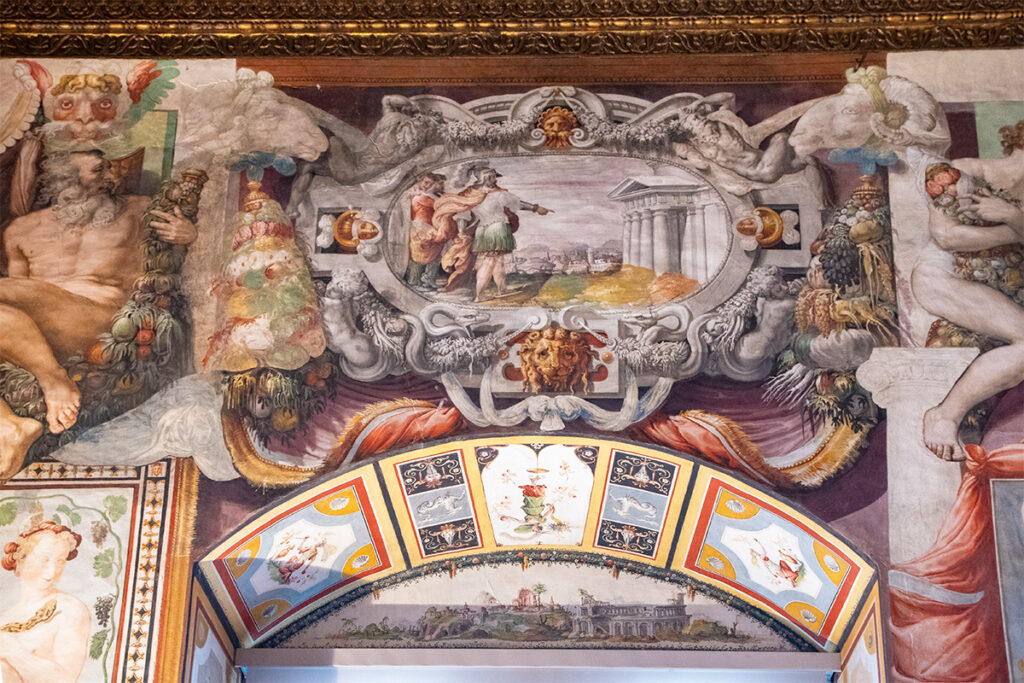
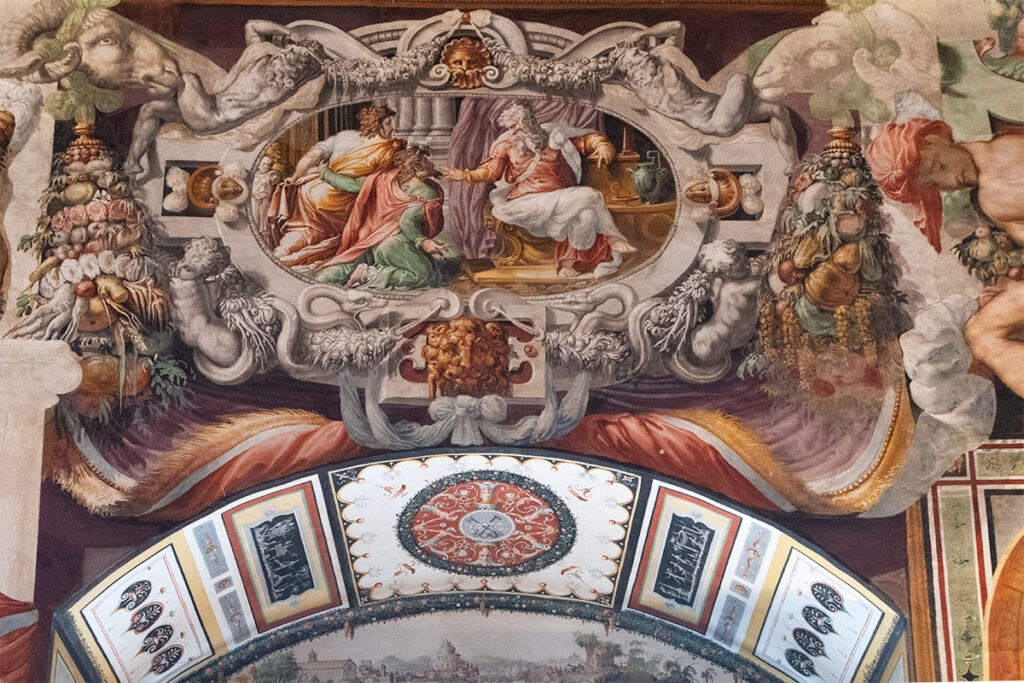
The windows in this chamber are decorated with exquisite frescoes, including Francesco Salvini’s Hecate (the Moon). And the view from these windows takes in Duomo and Giotto’s Campanile. It is probably the most artistically framed view in Florence.
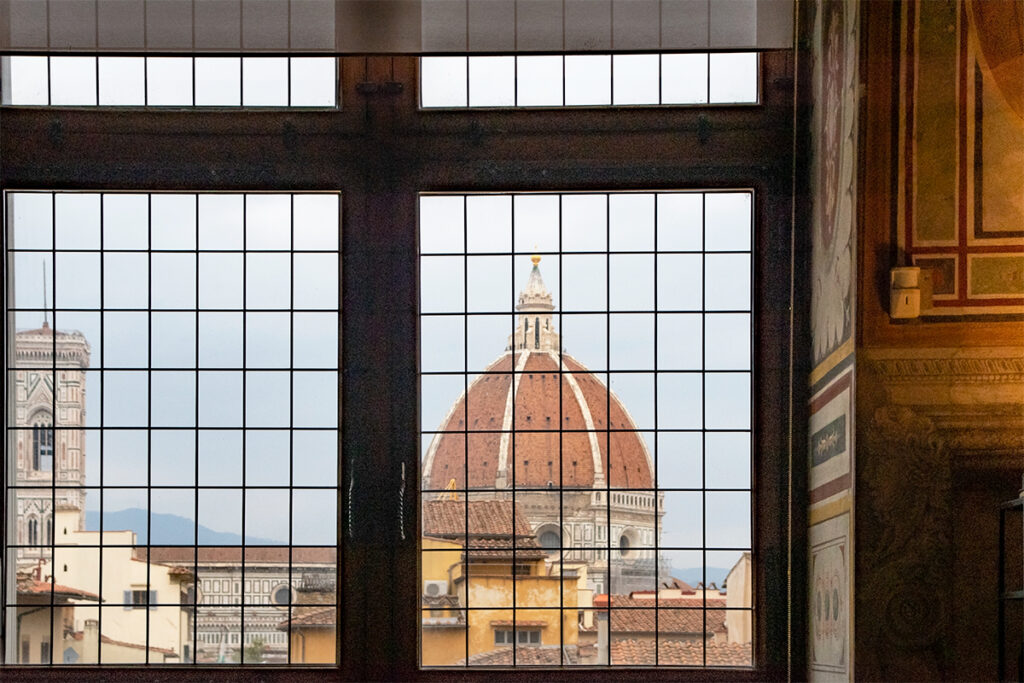
As you move through the doorway to the Hall of the Lilies, don’t miss the inlaid woodwork of the doors with portraits of Dante and Petrarch.
Hall of the Lilies
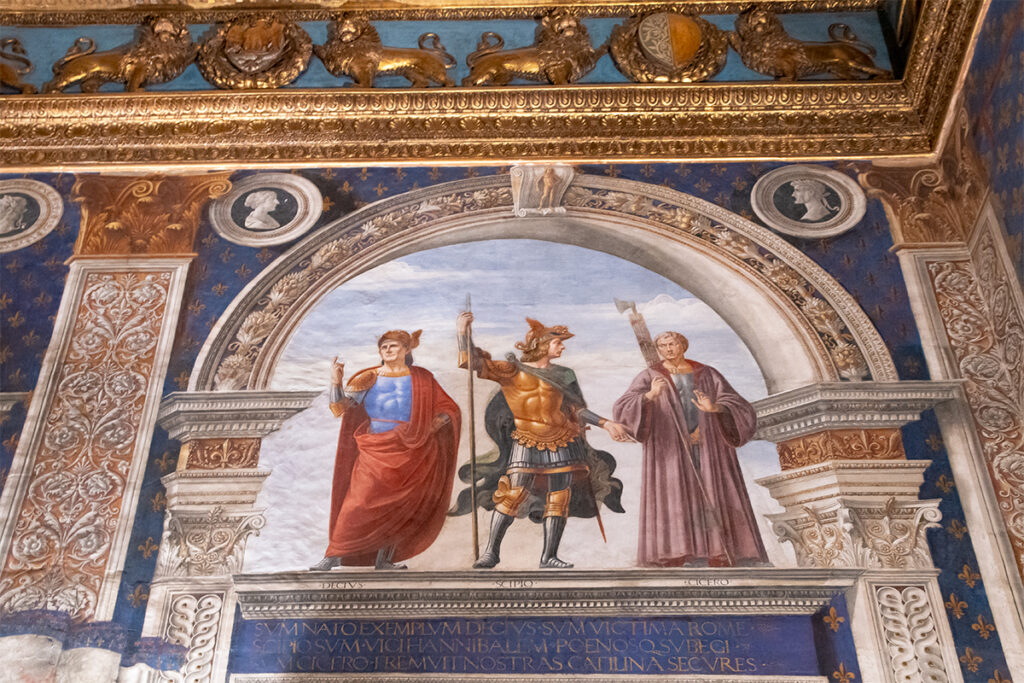
The Hall of the Lilies takes its name from the fleur-de-lys (the French lily) that decorate the ceiling and three walls, apparently, reflecting a brief period of friendship between the French crown and Florence.
The Roman-themed frescoes on the walls are the work of Domenico Ghirlandaio from the 1480s. Both the father and the son Ghirlandaios worked at different periods on making Palazzo Vecchio the masterpiece of Renaissance art.
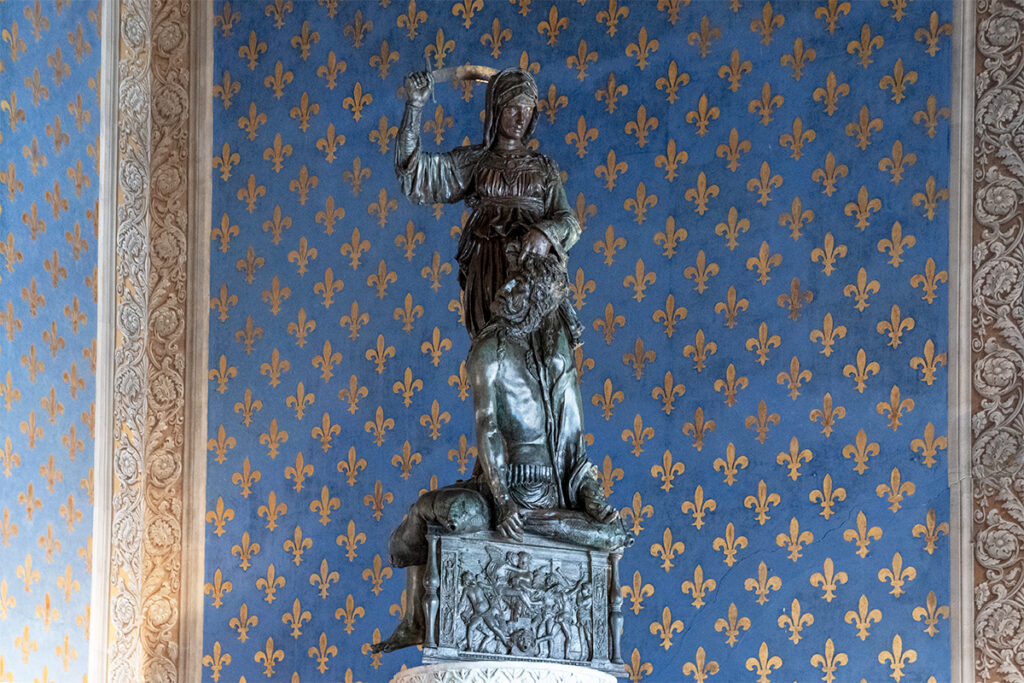
Donatello’s original Judith and Holofernes is the centrepiece of the Hall of Lilies. A copy of the statue is displayed outside of the palace, next to the Neptune fountain on Piazza della Signoria.
Hall of the Maps
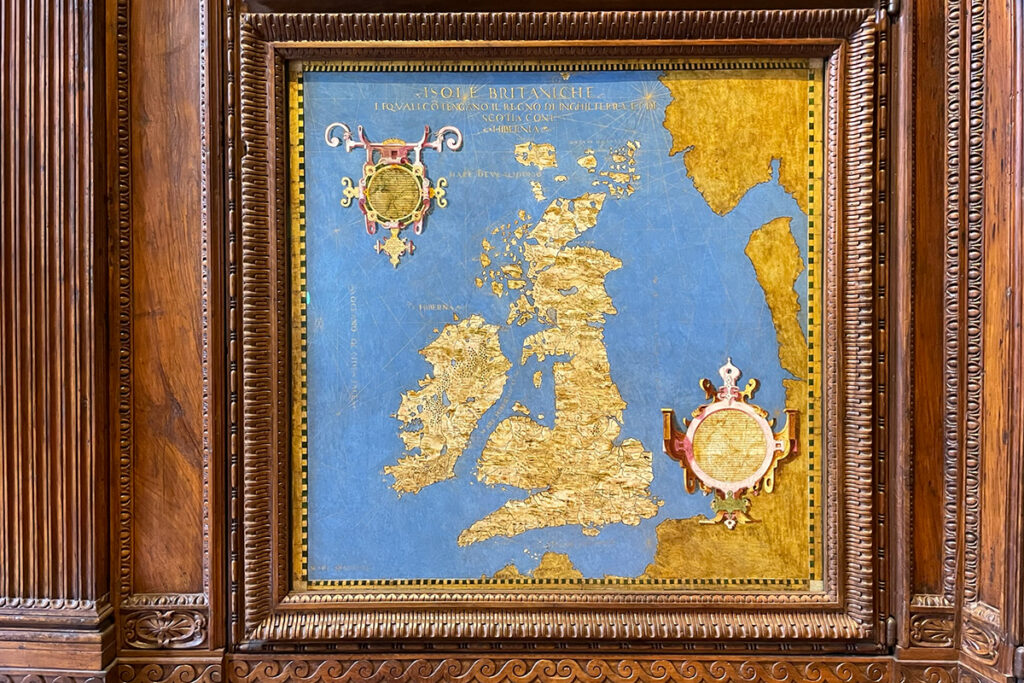
The tour of the palace concludes in a spectacular fashion at the Hall of Geographical Maps. Commissioned by Cosimo I, the room is a collection of 53 maps painted by Egnazio Danti and represents the most advanced knowledge of the world’s geography in the 16th century.
Just like Francesco’s and Cosimo’s study rooms, this room functioned as a cabinet of curiosities or a ‘wardrobe’, where Medici kept their most important possessions.
This room is a charming smaller cousin to the Vatican’s spectacular Hall of Maps. It is dominated by a massive globe known as Mappa Mundi, which in Cosimo’s time, was the largest globe in the world.
Old Chancellery
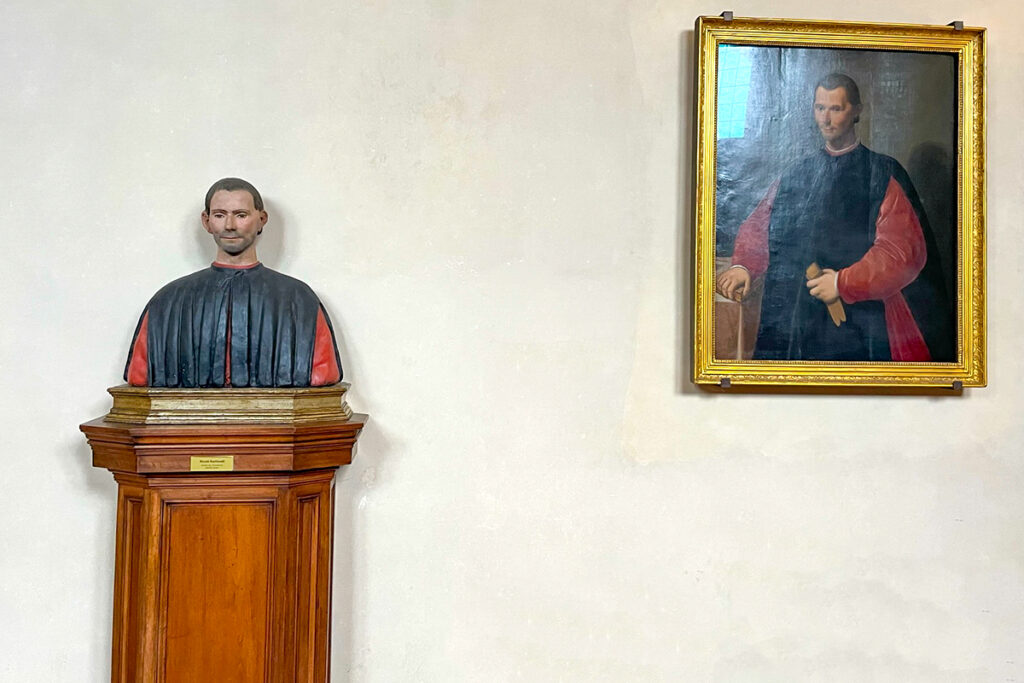
Before you leave, check out a small room next to the maps – the Old Chancellery. This was Niccolo Machiavelli’s office when he was Secretary of the Republic. Famous for his attitude of “the end justifies the means”, Machiavelli is considered the father of political science.
His terracotta bust displayed in the room is thought to have been modelled on his death mask, so it must be his close likeness.
Mezzanine
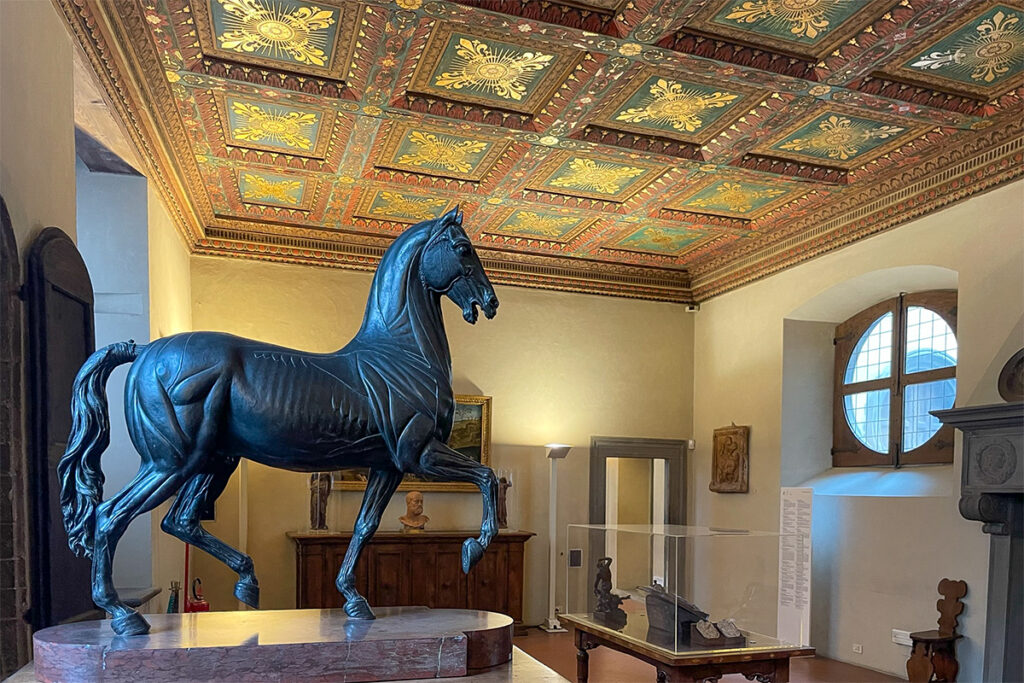
On your way down from the second floor, you come across another hidden gem – the Mezzanine. Located between the first and second floors, the mezzanine is the oldest part of the palace and it still carries its medieval ambience.
The mezzanine forms part of the old palace and It is the only part of the palace where you can see the original 14th- and 15th-century ceilings. The rooms here were modified by Michelozzo and later served as the living quarters of Maria Salviati, Cosimo I’s mother.
Today these rooms display a collection of art donated to the city of Florence by the American art historian Charles Loeser in 1928.
Palazzo Vecchio Tower
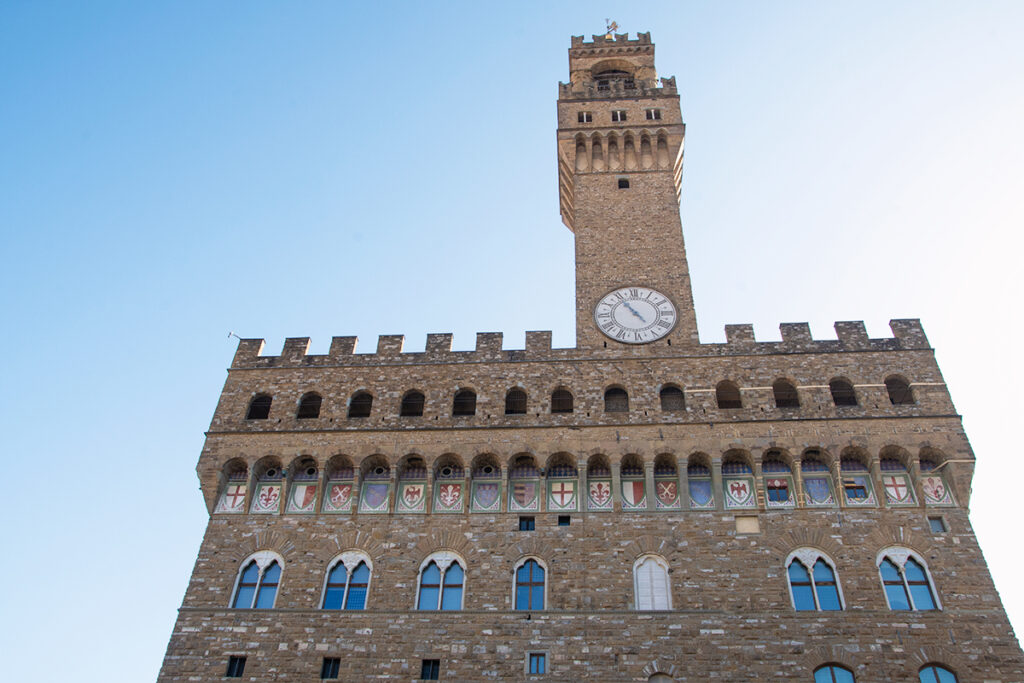
The last part of Palazzo Vecchio left to explore is the Arnolfo Tower – the palace’s bell tower. It takes some effort to climb 406 stone steps, but it’s an atmospheric hike through a narrow stone stairway.
As I mentioned above, you’ll need a separate ticket for the tower. If you plan to visit it at the same time as the palace, it’s best to get the tower ticket when you exchange your electronic Palazzo Vecchio tickets for the paper ones. Otherwise, the time slot you want might already be full.
You don’t have to visit the tower on the same day as the palace. It’s easy to visit the tower by itself.
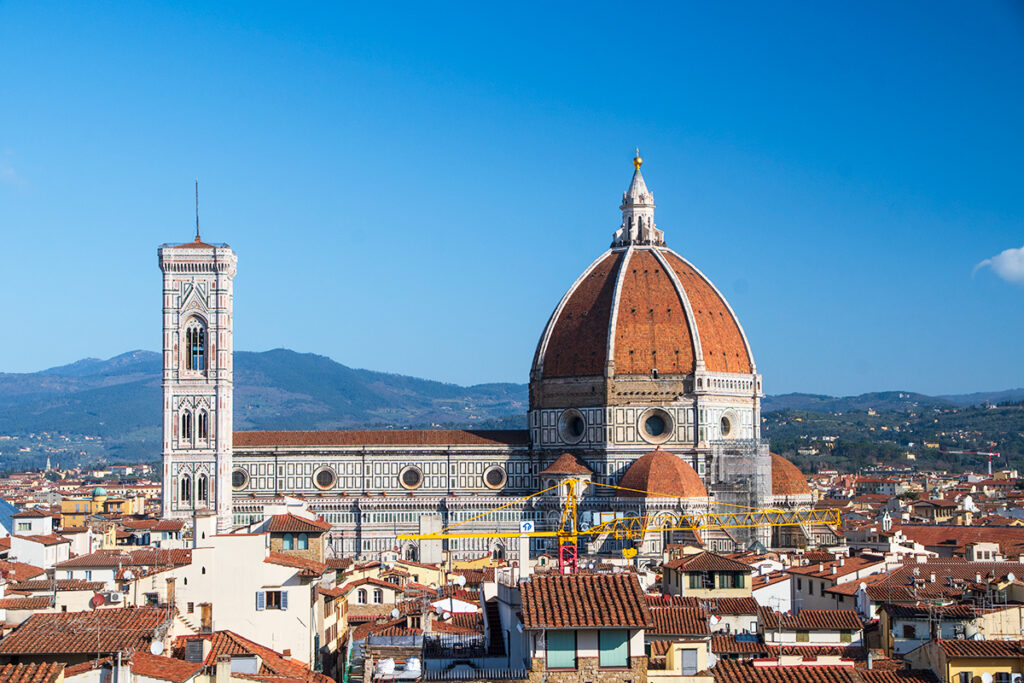
It takes some effort to climb 406 stone steps, but it’s an atmospheric hike through a narrow stone stairway.
At about two-thirds of the way up, you come to the battlements of the tower that wrap around the entire structure. The view from the battlements is spectacular. The Duomo is squarely in front of you, with Badia Fiorentina and Bargello towers soaring above the rooftops.
You can walk around the perimeter of the tower, taking in the views of the surrounding hills and the Arno River, snaking its way through the city under a series of bridges.
Make sure to take all the photos you want before you leave. You can only visit this platform on the way up. If you try to return here on the way down, the guard will politely show you back to the stairwell.
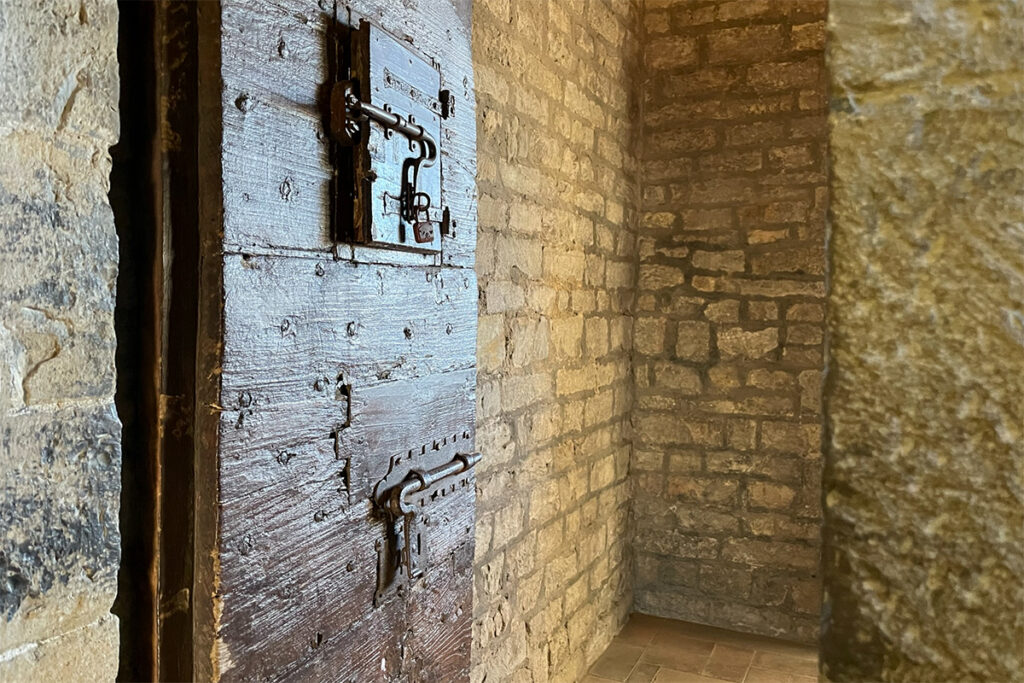
Continuing up towards the top of the tower, you’ll come across a little cell. Known as the Alberghetto, or “Little Hotel”, it is Florence’s most secret prison. Some of its famous guests include Cosimo il Vecchio and Girolamo Savonarola. If you watched The Medici TV Show, you’d be familiar with it (the show wasn’t filmed here).
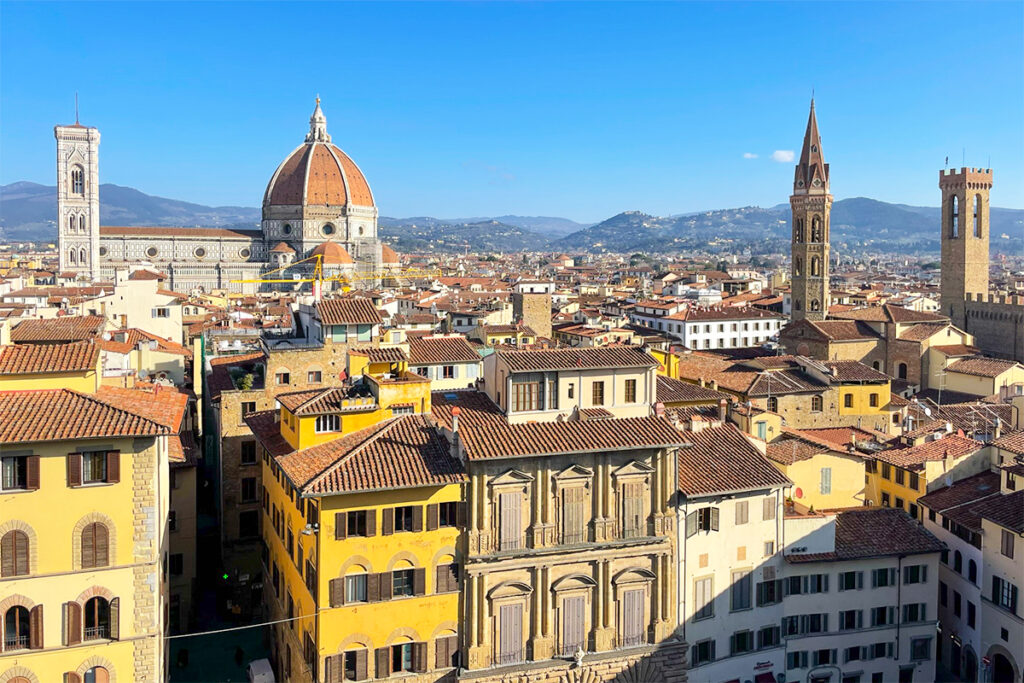
Shortly after the cell, you’ll reach the top of the tower. The view from here is truly wide-angle. The street looks miles away.
Gift shop
If you fall in love with Palazzo Vecchio as much as I did, don’t miss the gift shop in the second courtyard next to the ticket office. They sell some lovely tote bags and home decor bits and pierces with the mythical grotesque style patterns like in the palace frescoes.
More on Exploring Italy
- Renaissance Cats in Florence – A Feline Lovers Guide to Florentine Renaissance Art
- 3 Days in Florence – Exploring the Cradle of the Renaissance
- 2 Days in Florence: Detailed and Flexible Itinerary & Tips
- 1 Day in Florence Itinerary – the Best of the Italian Renaissance
- Things to Do in Florence in Winter and Why Visit in Winter
- Leonardo da Vinci in Florence: In the Footsteps of the Renaissance Master
- Guide to Visiting Palazzo Vecchio: Must-see Art and Hidden Gems
- Medici Florence – a Self-Guided Walk in the Cradle of the Renaissance
- 18 Weekend Breaks in Italy: Top Destinations to Visit and Things to Do
- Quo Vadis – Assisi B&B Where Comfort Meets Medieval Charm

